Hybrid Impedimetric Biosensors for Express Protein Markers Detection
Abstract
1. Introduction
2. Basic Principles of Impedimetric Measurements
3. Materials for Electrodes and Their Modifications
3.1. Metals
3.2. Conductive Oxides
3.3. Carbon Materials
3.4. Polymers
3.5. Metal Complexes of Porphyrins, Phthalocyanines, and Metal–Organic Frameworks
3.6. Metal Oxides and Dielectrics
3.7. Other Nanomaterials
4. Biorecognition Elements for Protein Detection
- (i).
- Change in thickness and dielectric constant of the recognition element layer. The binding of the analyte to the recognition element increases the thickness and dielectric constant of the layer, which leads to a change in capacitance [166] and an increase in resistance at the electrode surface [167]. This effect is observed when using thin layers of recognition elements such as antibodies or aptamers [168,169].
- (ii).
- Change in charge and conductivity of the recognition element layer. The binding of the analyte to the recognition element can change the charge and conductivity of the layer, which leads to a change in the potential and current at the electrode surface [170]. This effect is observed when using charged recognition elements such as nucleic acids [171] or peptides [172].
- (iii).
- Change in the conformation of the recognition element. The binding of an analyte to a recognition element can cause a change in its conformation, which leads to a change in capacitance and resistance to direct current on the surface of the electrode [173,174]. This effect is observed when using recognition elements that can change their structure when binding to the analyte, such as aptamers or enzymes [29,175,176].
- (i).
- Origin. Recognition elements can be natural or synthetic [177]. Natural recognition elements such as antibodies or enzymes usually have higher specificity and selectivity but are also more expensive, difficult to obtain and store, and are subject to degradation [178]. Synthetic recognition elements, such as aptamers, peptides, and nanobodies, generally have a lower cost, greater ease of synthesis and modification, and higher stability and regenerability [179].
- (ii).
- Size and molecular weight. Recognition elements can have different sizes, from several nanometers to several hundred nanometers, and different molecular weights. The size of the recognition element affects its properties, such as affinity, binding kinetics, mass transfer, electron transfer, and signal-to-noise ratio [180,181]. In general, the smaller size and molecular weight of the biorecognition element lead to faster and more sensitive detection due to the greater number of binding sites immobilized on the electrode surface [182]. In addition, the larger size and molecular weight of the biorecognition element increases its steric specificity, thereby reducing the likelihood of unwanted interactions with other molecules. This is especially important when studying the binding abilities of peptides and aptamers.
4.1. Impedimetric Detection of Proteins Using Antibodies
4.2. Aptamer-Based Impedimetric Biosensors
4.3. Peptide “Aptamers”
4.4. Other Types of Biorecognition Elements Used in Impedimetric Biosensors for Protein Detection
5. Integration of Impedimetric Biosensors into Microfluidic Systems
6. Conclusions
- (i).
- Selection and synthesis of suitable materials and nanostructures for electrodes that should provide good electrochemical activity, resistance to corrosion and degradation, and the ability to functionalize the surface for immobilization of bioligands.
- (ii).
- Development and optimization of methods for immobilizing biorecognition agents on the surface of electrodes, which should ensure specific, stable, and oriented binding to target proteins, as well as preservation of their activity and structure.
- (iii).
- Improving the specificity and sensitivity of biosensors, which should be able to detect low concentrations of proteins in complex biological matrices such as blood, serum, plasma, saliva, and urine, as well as distinguish between proteins with high degrees of homology or post-translational modifications.
- (iv).
- Reduction of the influence of interference and nonspecific binding, which can distort the biosensor signal and degrade its performance. Interference can be caused by electromagnetic fields, temperature, pH, salt composition, oxidizing or reducing agents, and other biomolecules present in the sample.
- (v).
- Adaptation of biosensors to real samples and operating conditions, which may differ from laboratory ones. For example, biosensors must be able to operate in a wide range of temperatures, humidities, pressures, and illuminations and also be resistant to mechanical damage and contamination.
- (vi).
- Expanding the range of detectable proteins that can be associated with various diseases, such as cancer, infections, autoimmune diseases, allergies, and others. To achieve this, it is necessary to develop new biorecognition agents that can specifically bind to proteins of interest and also take into account their structural and functional characteristics.
Author Contributions
Funding
Data Availability Statement
Conflicts of Interest
References
- Sidransky, D. Emerging Molecular Markers of Cancer. Nat. Rev. Cancer 2002, 2, 210–219. [Google Scholar] [CrossRef]
- Kaigorodova, E.; Bogatyuk, M. Heat Shock Proteins as Prognostic Markers of Cancer. Curr. Cancer Drug Targets 2014, 14, 713–726. [Google Scholar] [CrossRef] [PubMed]
- Wang, X.; Huang, J.; Chen, W.; Li, G.; Li, Z.; Lei, J. The Updated Role of Exosomal Proteins in the Diagnosis, Prognosis, and Treatment of Cancer. Exp. Mol. Med. 2022, 54, 1390–1400. [Google Scholar] [CrossRef] [PubMed]
- Dufour, J.-F. C-Reactive Protein, a Prognostic Marker in Hepatocellular Carcinoma. Hepatology 2013, 57, 2103–2105. [Google Scholar] [CrossRef] [PubMed]
- Schindler, M.; Walter, N.; Maderbacher, G.; Sigmund, I.K.; Alt, V.; Rupp, M. Novel Diagnostic Markers for Periprosthetic Joint Infection: A Systematic Review. Front. Cell. Infect. Microbiol. 2023, 13, 1210345. [Google Scholar] [CrossRef] [PubMed]
- Fischer, P.; Grigoras, C.; Bugariu, A.; Nicoara-Farcau, O.; Stefanescu, H.; Benea, A.; Hadade, A.; Margarit, S.; Sparchez, Z.; Tantau, M.; et al. Are Presepsin and Resistin Better Markers for Bacterial Infection in Patients with Decompensated Liver Cirrhosis? Dig. Liver Dis. 2019, 51, 1685–1691. [Google Scholar] [CrossRef] [PubMed]
- Tumani, H.; Brettschneider, J. Biochemical Markers of Autoimmune Diseases of the Nervous System. Curr. Pharm. Des. 2012, 18, 4556–4563. [Google Scholar] [CrossRef] [PubMed]
- Ogulur, I.; Pat, Y.; Ardicli, O.; Barletta, E.; Cevhertas, L.; Fernandez-Santamaria, R.; Huang, M.; Bel Imam, M.; Koch, J.; Ma, S.; et al. Advances and Highlights in Biomarkers of Allergic Diseases. Allergy 2021, 76, 3659–3686. [Google Scholar] [CrossRef]
- Klebes, A.; Kittel, A.-S.; Verboket, R.D.; von Stetten, F.; Früh, S.M. Multianalyte Lateral Flow Immunoassay for Simultaneous Detection of Protein-Based Inflammation Biomarkers and Pathogen DNA. Sens. Actuators B Chem. 2022, 355, 131283. [Google Scholar] [CrossRef]
- Mousavi, S.M.; Hashemi, S.A.; Kalashgrani, M.Y.; Gholami, A.; Omidifar, N.; Babapoor, A.; Vijayakameswara Rao, N.; Chiang, W.-H. Recent Advances in Plasma-Engineered Polymers for Biomarker-Based Viral Detection and Highly Multiplexed Analysis. Biosensors 2022, 12, 286. [Google Scholar] [CrossRef]
- Van Gool, A.; Corrales, F.; Čolović, M.; Krstić, D.; Oliver-Martos, B.; Martínez-Cáceres, E.; Jakasa, I.; Gajski, G.; Brun, V.; Kyriacou, K.; et al. Analytical Techniques for Multiplex Analysis of Protein Biomarkers. Expert Rev. Proteom. 2020, 17, 257–273. [Google Scholar] [CrossRef]
- Song, J.G.; Baral, K.C.; Kim, G.-L.; Park, J.-W.; Seo, S.-H.; Kim, D.-H.; Jung, D.H.; Ifekpolugo, N.L.; Han, H.-K. Quantitative Analysis of Therapeutic Proteins in Biological Fluids: Recent Advancement in Analytical Techniques. Drug Deliv. 2023, 30, 2183816. [Google Scholar] [CrossRef]
- Swami, S.; Kayenat, F.; Wajid, S. SPR Biosensing: Cancer Diagnosis and Biomarkers Quantification. Microchem. J. 2024, 197, 109792. [Google Scholar] [CrossRef]
- Karunakaran, R. Merve Keskin Biosensors: Components, Mechanisms, and Applications. In Analytical Techniques in Biosciences; Academic Press: Cambridge, MA, USA, 2022; pp. 179–190. [Google Scholar] [CrossRef]
- Zimina, T.M.; Sitkov, N.O.; Gareev, K.G.; Fedorov, V.; Grouzdev, D.S.; Koziaeva, V.V.; Gao, H.; Combs, S.E.; Shevtsov, M. Biosensors and Drug Delivery in Oncotheranostics Using Inorganic Synthetic and Biogenic Magnetic Nanoparticles. Biosensors 2022, 12, 789. [Google Scholar] [CrossRef] [PubMed]
- Singh, A.K.; Mittal, S.; Das, M.; Saharia, A.; Tiwari, M. Optical Biosensors: A Decade in Review. Alex. Eng. J. 2023, 67, 673–691. [Google Scholar] [CrossRef]
- Machado, M.; Oliveira, A.M.L.; Silva, G.A.; Bitoque, D.B.; Tavares Ferreira, J.; Pinto, L.A.; Ferreira, Q. Graphene Biosensors—A Molecular Approach. Nanomaterials 2022, 12, 1624. [Google Scholar] [CrossRef] [PubMed]
- Fethi, A.; Hicham, M. Carbon Electrodes as Emerging Platforms for Miniaturization of Electrochemical Biosensors. In Miniaturized Biosensing Devices; Springer: Singapore, 2022; pp. 39–55. [Google Scholar] [CrossRef]
- Khan, H.; Shah, M.R.; Barek, J.; Malik, M.I. Cancer Biomarkers and Their Biosensors: A Comprehensive Review. TrAC Trends Anal. Chem. 2023, 158, 116813. [Google Scholar] [CrossRef]
- Sanko, V.; Kuralay, F. Label-Free Electrochemical Biosensor Platforms for Cancer Diagnosis: Recent Achievements and Challenges. Biosensors 2023, 13, 333. [Google Scholar] [CrossRef] [PubMed]
- Nemati, M.; Farajzadeh, M.A.; Afshar Mogaddam, M.R.; Pourali, A. Recent Advances in Impedimetric Biosensors Focusing on Myocardial Infarction Diagnosis. Critical Rev. Anal. Chem. 2022, 1–14. [Google Scholar] [CrossRef]
- Antiochia, R. Electrochemical Biosensors for SARS-CoV-2 Detection: Voltametric or Impedimetric Transduction? Bioelectrochemistry 2022, 147, 108190. [Google Scholar] [CrossRef]
- Ullah, S.F.; Moreira, G.; Datta, S.P.A.; McLamore, E.; Vanegas, D. An Experimental Framework for Developing Point-of-Need Biosensors: Connecting Bio-Layer Interferometry and Electrochemical Impedance Spectroscopy. Biosensors 2022, 12, 938. [Google Scholar] [CrossRef]
- Dong, T.; Matos Pires, N.M.; Yang, Z.; Jiang, Z. Advances in Electrochemical Biosensors Based on Nanomaterials for Protein Biomarker Detection in Saliva. Adv. Sci. 2022, 10, e2205429. [Google Scholar] [CrossRef] [PubMed]
- Centane, S.; Nyokong, T. Aptamer versus Antibody as Probes for the Impedimetric Biosensor for Human Epidermal Growth Factor Receptor. J. Inorg. Biochem. 2022, 230, 111764. [Google Scholar] [CrossRef] [PubMed]
- Sinitsyna, V.V.; Vetcher, A.A. Nucleic Acid Aptamers in Nanotechnology. Biomedicines 2022, 10, 1079. [Google Scholar] [CrossRef]
- Wang, L.; Zhu, W.; Zhang, J.; Zhu, J.-J. Miniaturized Microfluidic Electrochemical Biosensors Powered by Enzymatic Biofuel Cell. Biosensors 2023, 13, 175. [Google Scholar] [CrossRef]
- Shimizu, F.M.; de Barros, A.; Braunger, M.L.; Gaal, G.; Riul, A., Jr. Information Visualization and Machine Learning Driven Methods for Impedimetric Biosensing. TrAC Trends Anal. Chem. 2023, 165, 117115. [Google Scholar] [CrossRef]
- Strong, M.E.; Richards, J.R.; Torres, M.; Beck, C.M.; La Belle, J.T. Faradaic Electrochemical Impedance Spectroscopy for Enhanced Analyte Detection in Diagnostics. Biosens. Bioelectron. 2021, 177, 112949. [Google Scholar] [CrossRef]
- Uygun, Z.O.; Ertuğrul Uygun, H.D. A Short Footnote: Circuit Design for Faradaic Impedimetric Sensors and Biosensors. Sens. Actuators B Chem. 2014, 202, 448–453. [Google Scholar] [CrossRef]
- Vivier, V.; Orazem, M.E. Impedance Analysis of Electrochemical Systems. Chem. Rev. 2022, 122, 11131–11168. [Google Scholar] [CrossRef]
- Castro Gutierrez, H.; Panigrahi, S. Selective Impedimetric Interdigitated Electrode for Sensing Gaseous, Biological, and Inorganic Targets: A State-of-The-Art Review. IEEE Sens. J. 2023. [Google Scholar] [CrossRef]
- Robinson, C.; Juska, V.B.; O’Riordan, A. Surface Chemistry Applications and Development of Immunosensors Using Electrochemical Impedance Spectroscopy: A Comprehensive Review. Environ. Res. 2023, 237, 116877. [Google Scholar] [CrossRef]
- Mariani, F.; Gualandi, I.; Schuhmann, W.; Scavetta, E. Micro- and Nano-Devices for Electrochemical Sensing. Microchim. Acta 2022, 189, 459. [Google Scholar] [CrossRef]
- Štukovnik, Z.; Bren, U. Recent Developments in Electrochemical-Impedimetric Biosensors for Virus Detection. Int. J. Mol. Sci. 2022, 23, 15922. [Google Scholar] [CrossRef] [PubMed]
- Haeverbeke, M.V.; Stock, M.; De Baets, B. Equivalent Electrical Circuits and Their Use Across Electrochemical Impedance Spectroscopy Application Domains. IEEE Access 2022, 10, 51363–51379. [Google Scholar] [CrossRef]
- Hui, Y.; Huang, Z.; Alahi, M.E.E.; Nag, A.; Feng, S.; Mukhopadhyay, S.C. Recent Advancements in Electrochemical Biosensors for Monitoring the Water Quality. Biosensors 2022, 12, 551. [Google Scholar] [CrossRef]
- Shlosberg, Y.; Sepunaru, L. Advantages of Imprinted Polymer Electrodes for Electrochemical Pathogen Detection. Curr. Opin. Electrochem. 2022, 36, 101123. [Google Scholar] [CrossRef]
- Pänke, O.; Balkenhohl, T.; Kafka, J.; Schäfer, D.; Lisdat, F. Impedance Spectroscopy and Biosensing. In Biosensing for the 21st Century; Advances in Biochemical Engineering/Biotechnology; Springer: Berlin/Heidelberg, Germany, 2007; pp. 195–237. [Google Scholar] [CrossRef]
- Sheen, H.-J.; Panigrahi, B.; Kuo, T.-R.; Hsu, W.-C.; Chung, P.-S.; Xie, Q.-Z.; Lin, C.-Y.; Chang, Y.-S.; Lin, C.-T.; Fan, Y.-J. Electrochemical Biosensor with Electrokinetics-Assisted Molecular Trapping for Enhancing C-Reactive Protein Detection. Biosens. Bioelectron. 2022, 210, 114338. [Google Scholar] [CrossRef]
- Kemp, N.T. A Tutorial on Electrochemical Impedance Spectroscopy and Nanogap Electrodes for Biosensing Applications. IEEE Sens. J. 2021, 21, 22232–22245. [Google Scholar] [CrossRef]
- Mwanza, D.; Adeniyi, O.; Tesfalidet, S.; Nyokong, T.; Mashazi, P. Capacitive Label-Free Ultrasensitive Detection of PSA on a Covalently Attached Monoclonal Anti-PSA Antibody Gold Surface. J. Electroanal. Chem. 2022, 927, 116983. [Google Scholar] [CrossRef]
- Otero, F.; Magner, E. Biosensors—Recent Advances and Future Challenges in Electrode Materials. Sensors 2020, 20, 3561. [Google Scholar] [CrossRef]
- Huang, X.; Zhu, Y.; Kianfar, E. Nano Biosensors: Properties, Applications and Electrochemical Techniques. J. Mater. Res. Technol. 2021, 12, 1649–1672. [Google Scholar] [CrossRef]
- Nasrin, F.; Khoris, I.M.; Chowdhury, A.D.; Boonyakida, J.; Park, E.Y. Impedimetric Biosensor of Norovirus with Low Variance Using Simple Bioconjugation on Conductive Polymer-Au Nanocomposite. Sens. Actuators B Chem. 2022, 369, 132390. [Google Scholar] [CrossRef]
- Dhamu, V.N.; Poudyal, D.C.; Samson, M.; Paul, A.; Muthukumar, S.; Prasad, S. Review—Environmental Biosensors for Agro-Safety Based on Electrochemical Sensing Mechanism with an Emphasis on Pesticide Screening. ECS Sens. Plus 2023, 2, 024601. [Google Scholar] [CrossRef]
- McCrae, L.E.; Ting, W.-T.; Howlader, M.M.R. Advancing Electrochemical Biosensors for Interleukin-6 Detection. Biosens. Bioelectron. X 2023, 13, 100288. [Google Scholar] [CrossRef]
- Subramani, I.G.; Perumal, V.; Gopinath, S.C.B.; Mohamed, N.M.; Joshi, N.; Ovinis, M.; Sze, L.L. 3D Nanoporous Hybrid Nanoflower for Enhanced Non-Faradaic Redox-Free Electrochemical Impedimetric Biodetermination. J. Taiwan Inst. Chem. Eng. 2020, 116, 26–35. [Google Scholar] [CrossRef]
- Ibau, C.; Arshad, M.K.M.; Gopinath, S.C.B.; Nuzaihan, M.N.M.; Fathil, M.F.M.; Shamsuddin, S.A. Immunosensing Prostate-Specific Antigen: Faradaic vs Non-Faradaic Electrochemical Impedance Spectroscopy Analysis on Interdigitated Microelectrode Device. Int. J. Biol. Macromol. 2020, 162, 1924–1936. [Google Scholar] [CrossRef] [PubMed]
- Daniels, J.S.; Pourmand, N. Label-Free Impedance Biosensors: Opportunities and Challenges. Electroanalysis 2007, 19, 1239–1257. [Google Scholar] [CrossRef]
- Chen, B.; Kiely, J.; Williams, I.; Luxton, R. A Non-Faradaic Impedimetric Biosensor for Monitoring of Caspase 9 in Mammalian Cell Culture. SSRN Electron. J. 2023, 153, 108456. [Google Scholar] [CrossRef]
- Neshani, S.; Momeni, K.; Chen, D.J.; Neihart, N.M. Highly Sensitive Readout Interface for Real-Time Differential Precision Measurements with Impedance Biosensors. Biosensors 2023, 13, 77. [Google Scholar] [CrossRef]
- Buscaglia, L.A.; Oliveira, O.N.; Carmo, J. Roadmap for Electrical Impedance Spectroscopy for Sensing: A Tutorial. IEEE Sens. J. 2021, 21, 22246–22257. [Google Scholar] [CrossRef]
- Pinkova Gajdosova, V.; Lorencova, L.; Blsakova, A.; Kasak, P.; Bertok, T.; Tkac, J. Challenges for Impedimetric Affinity Sensors Targeting Protein Detection. Curr. Opin. Electrochem. 2021, 28, 100717. [Google Scholar] [CrossRef]
- Guan, J.-G.; Miao, Y.-Q.; Zhang, Q.-J. Impedimetric Biosensors. J. Biosci. Bioeng. 2004, 97, 219–226. [Google Scholar] [CrossRef] [PubMed]
- Bhand, S.; Bacher, G. Impedimetric Sensors in Environmental Analysis: An Overview. In Environmental, Chemical and Medical Sensors; Springer: Singapore, 2017; pp. 67–85. [Google Scholar] [CrossRef]
- Chinnadayyala, S.R.; Park, J.; Abbasi, M.A.; Cho, S. Label-Free Electrochemical Impedimetric Immunosensor for Sensitive Detection of IgM Rheumatoid Factor in Human Serum. Biosens. Bioelectron. 2019, 143, 111642. [Google Scholar] [CrossRef]
- Cecchetto, J.; Carvalho, F.C.; Santos, A.; Fernandes, F.C.B.; Bueno, P.R. An Impedimetric Biosensor to Test Neat Serum for Dengue Diagnosis. Sens. Actuators B Chem. 2015, 213, 150–154. [Google Scholar] [CrossRef]
- Białobrzeska, W.; Ficek, M.; Dec, B.; Osella, S.; Trzaskowski, B.; Jaramillo-Botero, A.; Pierpaoli, M.; Rycewicz, M.; Dashkevich, Y.; Łęga, T.; et al. Performance of Electrochemical Immunoassays for Clinical Diagnostics of SARS-CoV-2 Based on Selective Nucleocapsid N Protein Detection: Boron-Doped Diamond, Gold and Glassy Carbon Evaluation. Biosens. Bioelectron. 2022, 209, 114222. [Google Scholar] [CrossRef] [PubMed]
- Bryan, T.; Luo, X.; Bueno, P.R.; Davis, J.J. An Optimised Electrochemical Biosensor for the Label-Free Detection of C-Reactive Protein in Blood. Biosens. Bioelectron. 2013, 39, 94–98. [Google Scholar] [CrossRef]
- Singh, K.V.; Bhura, D.K.; Nandamuri, G.; Whited, A.M.; Evans, D.; King, J.; Solanki, R. Nanoparticle-Enhanced Sensitivity of a Nanogap-Interdigitated Electrode Array Impedimetric Biosensor. Langmuir 2011, 27, 13931–13939. [Google Scholar] [CrossRef]
- Schrattenecker, J.D.; Heer, R.; Hainberger, R.; Fafilek, G. Impedimetric IgG-Biosensor with In-Situ Generation of the Redox-Probe. Proceedings 2017, 1, 534. [Google Scholar] [CrossRef]
- Wang, S.X.; Acha, D.; Shah, A.J.; Hills, F.; Roitt, I.; Demosthenous, A.; Bayford, R.H. Detection of the Tau Protein in Human Serum by a Sensitive Four-Electrode Electrochemical Biosensor. Biosens. Bioelectron. 2017, 92, 482–488. [Google Scholar] [CrossRef]
- Ruankham, W.; Morales Frías, I.A.; Phopin, K.; Tantimongcolwat, T.; Bausells, J.; Zine, N.; Errachid, A. One-Step Impedimetric NT-ProBNP Aptasensor Targeting Cardiac Insufficiency in Artificial Saliva. Talanta 2023, 256, 124280. [Google Scholar] [CrossRef]
- Pal, A.; Biswas, S.; Kare, S.P.O.; Biswas, P.; Jana, S.K.; Das, S.; Chaudhury, K. Development of an Impedimetric Immunosensor for Machine Learning-Based Detection of Endometriosis: A Proof of Concept. Sens. Actuators B Chem. 2021, 346, 130460. [Google Scholar] [CrossRef]
- Bachour Junior, B.; Batistuti, M.R.; Pereira, A.S.; de Sousa Russo, E.M.; Mulato, M. Electrochemical Aptasensor for NS1 Detection: Towards a Fast Dengue Biosensor. Talanta 2021, 233, 122527. [Google Scholar] [CrossRef]
- Yağar, H.; Özcan, H.M.; Mehmet, O. A New Electrochemical Impedance Biosensor Based on Aromatic Thiol for Alpha-1 Antitrypsin Determination. Turk. J. Chem. 2021, 45, 104–118. [Google Scholar] [CrossRef]
- Ben Messaoud, N.; Barreiros dos Santos, M.; Trocado, V.; Nogueira-Silva, C.; Queirós, R. A Novel Label-Free Electrochemical Immunosensor for Detection of Surfactant Protein B in Amniotic Fluid. Talanta 2023, 251, 123744. [Google Scholar] [CrossRef]
- Díaz-Fernández, A.; Miranda-Castro, R.; de-los-Santos-Álvarez, N.; Lobo-Castañón, M.J.; Estrela, P. Impedimetric Aptamer-Based Glycan PSA Score for Discrimination of Prostate Cancer from Other Prostate Diseases. Biosens. Bioelectron. 2021, 175, 112872. [Google Scholar] [CrossRef]
- Nan, M.-N.; Bi, Y.; Xue, H.-L.; Long, H.-T.; Xue, S.-L.; Pu, L.-M.; Prusky, D. Modification Performance and Electrochemical Characteristics of Different Groups of Modified Aptamers Applied for Label-Free Electrochemical Impedimetric Sensors. Food Chem. 2021, 337, 127761. [Google Scholar] [CrossRef]
- Svigelj, R.; Zuliani, I.; Grazioli, C.; Dossi, N.; Toniolo, R. An Effective Label-Free Electrochemical Aptasensor Based on Gold Nanoparticles for Gluten Detection. Nanomaterials 2022, 12, 987. [Google Scholar] [CrossRef] [PubMed]
- Tertis, M.; Leva, P.I.; Bogdan, D.; Suciu, M.; Graur, F.; Cristea, C. Impedimetric Aptasensor for the Label-Free and Selective Detection of Interleukin-6 for Colorectal Cancer Screening. Biosens. Bioelectron. 2019, 137, 123–132. [Google Scholar] [CrossRef] [PubMed]
- Aydın, E.B.; Sezgintürk, M.K. An Impedimetric Immunosensor for Highly Sensitive Detection of IL-8 in Human Serum and Saliva Samples: A New Surface Modification Method by 6-Phosphonohexanoic Acid for Biosensing Applications. Anal. Biochem. 2018, 554, 44–52. [Google Scholar] [CrossRef] [PubMed]
- Aydın, E.B.; Sezgintürk, M.K. Ultrasensitive Detection of Interleukin 1α Using 3-Phosphonopropionic Acid Modified FTO Surface as an Effective Platform for Disposable Biosensor Fabrication. Bioelectrochemistry 2021, 138, 107698. [Google Scholar] [CrossRef] [PubMed]
- Gündoğdu, A.; Aydın, E.B.; Sezgintürk, M.K. A Novel Electrochemical Immunosensor Based on ITO Modified by Carboxyl-Ended Silane Agent for Ultrasensitive Detection of MAGE-1 in Human Serum. Anal. Biochem. 2017, 537, 84–92. [Google Scholar] [CrossRef]
- Yılmaz, N.; Aydın, E.B.; Sezgintürk, M.K. An Epoxysilane Modified Indium Tin Oxide Electrode for the Determination of PAK 2: Application in Human Serum Samples. Anal. Chim. Acta 2019, 1062, 68–77. [Google Scholar] [CrossRef]
- Demirbakan, B.; Sezgintürk, M.K. A Novel Electrochemical Immunosensor Based on Disposable ITO-PET Electrodes for Sensitive Detection of PAK 2 Antigen. J. Electroanal. Chem. 2019, 848, 113304. [Google Scholar] [CrossRef]
- Nur Altay, D.; Yagar, H.; Ozcan, H.M. A new ITO-based Aβ42 biosensor for early detection of Alzheimer’s disease. Bioelectrochemistry 2023, 153, 108501. [Google Scholar] [CrossRef]
- Yang, Y.-P.; Lu, Y.-L.; Kumar Gupta, A.; Lin, S.-P. Real-Time Impedimetric Detection of Cardiac Troponin I Using ITO-Coated Vertically Aligned Silicon Nanowires. Mater. Lett. 2022, 311, 131575. [Google Scholar] [CrossRef]
- Moro, G.; Ferrari, L.; Angelini, A.; Polo, F. An Impedimetric Biosensing Strategy Based on BicyclicPeptides as Bioreceptors for Monitoring H-UPA Cancer Biomarkers. Chemosensors 2023, 11, 234. [Google Scholar] [CrossRef]
- Senturk, H.; Eksin, E.; Işık, Ö.; İlaslan, Z.; Mısırlı, F.; Erdem, A. Impedimetric Aptasensor for Lysozyme Detection Based on Carbon Nanofibres Enriched Screen-Printed Electrodes. Electrochim. Acta 2021, 377, 138078. [Google Scholar] [CrossRef]
- Khan, R.; Pal, M.; Kuzikov, A.V.; Bulko, T.; Suprun, E.V.; Shumyantseva, V.V. Impedimetric Immunosensor for Detection of Cardiovascular Disorder Risk Biomarker. Mater. Sci. Eng. C 2016, 68, 52–58. [Google Scholar] [CrossRef]
- Kara, P.; de la Escosura-Muñiz, A.; Maltez-da Costa, M.; Guix, M.; Ozsoz, M.; Merkoçi, A. Aptamers Based Electrochemical Biosensor for Protein Detection Using Carbon Nanotubes Platforms. Biosens. Bioelectron. 2010, 26, 1715–1718. [Google Scholar] [CrossRef] [PubMed]
- Rohrbach, F.; Karadeniz, H.; Erdem, A.; Famulok, M.; Mayer, G. Label-Free Impedimetric Aptasensor for Lysozyme Detection Based on Carbon Nanotube-Modified Screen-Printed Electrodes. Anal. Biochem. 2012, 421, 454–459. [Google Scholar] [CrossRef] [PubMed]
- Azzouzi, S.; Ben Ali, M.; Bellagambi, F.; Elaissari, A.; Jaffrezic-Renault, N.; Errachid, A.; Zine, N. Spatially Hierarchical Nano-Architecture for Real Time Detection of Interleukin-8 Cancer Biomarker. Talanta 2022, 246, 123436. [Google Scholar] [CrossRef]
- Sonuç Karaboğa, M.N.; Sezgintürk, M.K. A Nano-Composite Based Regenerative Neuro Biosensor Sensitive to Parkinsonism-Associated Protein DJ-1/Park7 in Cerebrospinal Fluid and Saliva. Bioelectrochemistry 2021, 138, 107734. [Google Scholar] [CrossRef]
- Ghanavati, M.; Tadayon, F.; Bagheri, H. A Novel Label-Free Impedimetric Immunosensor for Sensitive Detection of Prostate Specific Antigen Using Au Nanoparticles/MWCNTs-Graphene Quantum Dots Nanocomposite. Microchem. J. 2020, 159, 105301. [Google Scholar] [CrossRef]
- Demirbakan, B.; Kemal Sezgintürk, M. An Impedimetric Biosensor System Based on Disposable Graphite Paper Electrodes: Detection of ST2 as a Potential Biomarker for Cardiovascular Disease in Human Serum. Anal. Chim. Acta 2021, 1144, 43–52. [Google Scholar] [CrossRef]
- Özcan, B.; Sezgintürk, M.K. Highly Sensitive and Single-Use Biosensing System Based on a GP Electrode for Analysis of Adiponectin, an Obesity Biomarker. ACS Biomater. Sci. Eng. 2021, 7, 3658–3668. [Google Scholar] [CrossRef]
- Demirbakan, B.; Sezgintürk, M.K. An Electrochemical Immunosensor Based on Graphite Paper Electrodes for the Sensitive Detection of Creatine Kinase in Actual Samples. J. Electroanal. Chem. 2022, 921, 116656. [Google Scholar] [CrossRef]
- Witt, S.; Rogien, A.; Werner, D.; Siegenthaler, J.; Lesiyon, R.; Kurien, N.; Rechenberg, R.; Baule, N.; Hardy, A.; Becker, M. Boron Doped Diamond Thin Films for the Electrochemical Detection of SARS-CoV-2 S1 Protein. Diam. Relat. Mater. 2021, 118, 108542. [Google Scholar] [CrossRef]
- Frias, I.A.M.; Zine, N.; Sigaud, M.; Lozano-Sanchez, P.; Caffio, M.; Errachid, A. Non-Covalent π–π Functionalized Gii-Sense® Graphene Foam for Interleukin 10 Impedimetric Detection. Biosens. Bioelectron. 2023, 222, 114954. [Google Scholar] [CrossRef] [PubMed]
- Filip, J.; Zavahir, S.; Klukova, L.; Tkac, J.; Kasak, P. Immobilization of Concanavalin A Lectin on a Reduced Graphene Oxide-Thionine Surface by Glutaraldehyde Crosslinking for the Construction of an Impedimetric Biosensor. J. Electroanal. Chem. 2017, 794, 156–163. [Google Scholar] [CrossRef]
- Sonuç Karaboga, M.N.; Sezgintürk, M.K. Analysis of Tau-441 Protein in Clinical Samples Using RGO/AuNP Nanocomposite-Supported Disposable Impedimetric Neuro-Biosensing Platform: Towards Alzheimer’s Disease Detection. Talanta 2020, 219, 121257. [Google Scholar] [CrossRef]
- Kazemi, S.H.; Ghodsi, E.; Abdollahi, S.; Nadri, S. Porous Graphene Oxide Nanostructure as an Excellent Scaffold for Label-Free Electrochemical Biosensor: Detection of Cardiac Troponin I. Mater. Sci. Eng. C 2016, 69, 447–452. [Google Scholar] [CrossRef]
- Jozghorbani, M.; Fathi, M.; Kazemi, S.H.; Alinejadian, N. Determination of Carcinoembryonic Antigen as a Tumor Marker Using a Novel Graphene-Based Label-Free Electrochemical Immunosensor. Anal. Biochem. 2021, 613, 114017. [Google Scholar] [CrossRef]
- Harmanci, D.; Onur Uygun, Z.; Koçak Sezgin, A.; Demirdöver, C.; Girgin Sagin, F.; Akdoğan, G. Rapid Fibroblast Cell Culture Characterization with Impedimetric Label-free Heat Shock Protein—47 Biosensor. Electroanalysis 2020, 32, 2310–2315. [Google Scholar] [CrossRef]
- Yagati, A.K.; Pyun, J.-C.; Min, J.; Cho, S. Label-Free and Direct Detection of C-Reactive Protein Using Reduced Graphene Oxide-Nanoparticle Hybrid Impedimetric Sensor. Bioelectrochemistry 2016, 107, 37–44. [Google Scholar] [CrossRef]
- Brodowski, M.; Kowalski, M.; Skwarecka, M.; Pałka, K.; Skowicki, M.; Kula, A.; Lipiński, T.; Dettlaff, A.; Ficek, M.; Ryl, J.; et al. Highly Selective Impedimetric Determination of Haemophilus Influenzae Protein D Using Maze-like Boron-Doped Carbon Nanowall Electrodes. Talanta 2021, 221, 121623. [Google Scholar] [CrossRef]
- Wang, C.; Li, J.; Kang, M.; Huang, X.; Liu, Y.; Zhou, N.; Zhang, Z. Nanodiamonds and Hydrogen-Substituted Graphdiyne Heteronanostructure for the Sensitive Impedimetric Aptasensing of Myocardial Infarction and Cardiac Troponin I. Anal. Chim. Acta 2021, 1141, 110–119. [Google Scholar] [CrossRef]
- Zakaria, N.; Mohd, Y.; Chin, L.Y.; Jalil, M.N.; Zain, Z.M. Poly-Ortho-Phenylenediamine Modified Pt/Ir Microelectrode as Impedimetric Biosensor. Int. J. Electrochem. Sci. 2021, 16, 210736. [Google Scholar] [CrossRef]
- Hassan-Nixon, H.A.G.; Singh, N.; Cass, A.E.G. A Sensitive Impedimetric Immunosensor for the Detection of Interleukin-8 in Nasal Epithelial Lining Fluid of Asthma Patients. Biosens. Bioelectron. X 2022, 10, 100118. [Google Scholar] [CrossRef]
- Thangsunan, P.; Lal, N.; Tiede, C.; Moul, S.; Robinson, J.I.; Knowles, M.A.; Stockley, P.G.; Beales, P.A.; Tomlinson, D.C.; McPherson, M.J.; et al. Affimer-Based Impedimetric Biosensors for Fibroblast Growth Factor Receptor 3 (FGFR3): A Novel Tool for Detection and Surveillance of Recurrent Bladder Cancer. Sens. Actuators B Chem. 2021, 326, 128829. [Google Scholar] [CrossRef]
- Rushworth, J.V.; Ahmed, A.; Griffiths, H.H.; Pollock, N.M.; Hooper, N.M.; Millner, P.A. A Label-Free Electrical Impedimetric Biosensor for the Specific Detection of Alzheimer’s Amyloid-Beta Oligomers. Biosens. Bioelectron. 2014, 56, 83–90. [Google Scholar] [CrossRef] [PubMed]
- Shamsuddin, S.H.; Gibson, T.D.; Tomlinson, D.C.; McPherson, M.J.; Jayne, D.G.; Millner, P.A. Reagentless Affimer- and Antibody-Based Impedimetric Biosensors for CEA-Detection Using a Novel Non-Conducting Polymer. Biosens. Bioelectron. 2021, 178, 113013. [Google Scholar] [CrossRef]
- Aydın, E.B. Highly Sensitive Impedimetric Immunosensor for Determination of Interleukin 6 as a Cancer Biomarker by Using Conjugated Polymer Containing Epoxy Side Groups Modified Disposable ITO Electrode. Talanta 2020, 215, 120909. [Google Scholar] [CrossRef]
- María Dip Gandarilla, A.; Correa Glória, J.; Romaguera Barcelay, Y.; de Souza, R.F.B.; André Morais Mariuba, L.; Ricardo Brito, W. Application of Egg Yolk IgY on Carboxylated Polypyrrole Films for Impedimetric Detection of PfHRP2 Antigen. Bioelectrochemistry 2022, 148, 108273. [Google Scholar] [CrossRef]
- Yuan, G.; He, J.; Li, Y.; Xu, W.; Gao, L.; Yu, C. A Novel Ultrasensitive Electrochemical Immunosensor Based on Carboxy-Endcapped Conductive Polypyrrole for the Detection of Gypican-3 in Human Serum. Anal. Methods 2015, 7, 1745–1750. [Google Scholar] [CrossRef]
- Aydın, E.B.; Aydın, M.; Sezgintürk, M.K. Fabrication of Electrochemical Immunosensor Based on Acid-Substituted Poly(Pyrrole) Polymer Modified Disposable ITO Electrode for Sensitive Detection of CCR4 Cancer Biomarker in Human Serum. Talanta 2021, 222, 121487. [Google Scholar] [CrossRef]
- Aydın, E.B.; Aydın, M.; Sezgintürk, M.K. A Label-Free Electrochemical Biosensor for Highly Sensitive Detection of GM2A Based on Gold Nanoparticles/Conducting Amino-Functionalized Thiophene Polymer Layer. Sens. Actuators B Chem. 2023, 392, 134025. [Google Scholar] [CrossRef]
- Aydın, E.B.; Aydın, M.; Sezgintürk, M.K. A Novel Electrochemical Immunosensor Based on Acetylene Black/Epoxy-Substituted-Polypyrrole Polymer Composite for the Highly Sensitive and Selective Detection of Interleukin 6. Talanta 2021, 222, 121596. [Google Scholar] [CrossRef]
- Amouzadeh Tabrizi, M.; Shamsipur, M.; Mostafaie, A. A High Sensitive Label-Free Immunosensor for the Determination of Human Serum IgG Using Overoxidized Polypyrrole Decorated with Gold Nanoparticle Modified Electrode. Mater. Sci. Eng. C 2016, 59, 965–969. [Google Scholar] [CrossRef]
- Taheri, N.; Khoshsafar, H.; Ghanei, M.; Ghazvini, A.; Bagheri, H. Dual-Template Rectangular Nanotube Molecularly Imprinted Polypyrrole for Label-Free Impedimetric Sensing of AFP and CEA as Lung Cancer Biomarkers. Talanta 2022, 239, 123146. [Google Scholar] [CrossRef]
- Aydın, E.B.; Aydın, M.; Sezgintürk, M.K. New Impedimetric Sandwich Immunosensor for Ultrasensitive and Highly Specific Detection of Spike Receptor Binding Domain Protein of SARS-CoV-2. ACS Biomater. Sci. Eng. 2021, 7, 3874–3885. [Google Scholar] [CrossRef]
- Ruecha, N.; Shin, K.; Chailapakul, O.; Rodthongkum, N. Label-Free Paper-Based Electrochemical Impedance Immunosensor for Human Interferon Gamma Detection. Sens. Actuators B Chem. 2019, 279, 298–304. [Google Scholar] [CrossRef]
- Kim, M.; Iezzi, R.; Shim, B.S.; Martin, D.C. Impedimetric Biosensors for Detecting Vascular Endothelial Growth Factor (VEGF) Based on Poly(3,4-Ethylene Dioxythiophene) (PEDOT)/Gold Nanoparticle (Au NP) Composites. Front. Chem. 2019, 7, 234. [Google Scholar] [CrossRef]
- Xu, M.; Yadavalli, V.K. Flexible Biosensors for the Impedimetric Detection of Protein Targets Using Silk-Conductive Polymer Biocomposites. ACS Sens. 2019, 4, 1040–1047. [Google Scholar] [CrossRef]
- Aydın, E.B.; Aydın, M.; Sezgintürk, M.K. A novel electrochemical impedance immunosensor for the quantification of CYFRA 21-1 in human serum. Microchim. Acta 2023, 190, 235. [Google Scholar] [CrossRef]
- Karami, P.; Bagheri, H.; Johari-Ahar, M.; Khoshsafar, H.; Arduini, F.; Afkhami, A. Dual-Modality Impedimetric Immunosensor for Early Detection of Prostate-Specific Antigen and Myoglobin Markers Based on Antibody-Molecularly Imprinted Polymer. Talanta 2019, 202, 111–122. [Google Scholar] [CrossRef]
- Özcan, B.; Sezgintürk, M.K. A Novel and Disposable GP- Based Impedimetric Biosensor Using Electropolymerization Process with PGA for Highly Sensitive Determination of Leptin: Early Diagnosis of Childhood Obesity. Talanta 2021, 225, 121985. [Google Scholar] [CrossRef]
- Xia, N.; Huang, Y.; Cui, Z.; Liu, S.; Deng, D.; Liu, L.; Wang, J. Impedimetric Biosensor for Assay of Caspase-3 Activity and Evaluation of Cell Apoptosis Using Self-Assembled Biotin-Phenylalanine Network as Signal Enhancer. Sens. Actuators B Chem. 2020, 320, 128436. [Google Scholar] [CrossRef]
- Lobato, A.; Šubic, M.; Romih, T.; Žibret, L.; Metarapi, D.; Benčina, M.; Jerala, R.; Vidović, K.; Hočevar, S.B.; Tasić, N. Development of a Simple Gelatin-Based Sensing Platform for the Sensitive Label-Free Impedimetric Detection of SARS-CoV-2. Electrochim. Acta 2023, 463, 142823. [Google Scholar] [CrossRef]
- Ben Hassine, A.; Raouafi, N.; Moreira, F.T.C. Novel Electrochemical Molecularly Imprinted Polymer-Based Biosensor for Tau Protein Detection. Chemosensors 2021, 9, 238. [Google Scholar] [CrossRef]
- Yang, J.C.; Cho, C.H.; Choi, D.Y.; Park, J.P.; Park, J. Microcontact Surface Imprinting of Affinity Peptide for Electrochemical Impedimetric Detection of Neutrophil Gelatinase-Associated Lipocalin. Sens. Actuators B Chem. 2022, 364, 131916. [Google Scholar] [CrossRef]
- Tugce Yaman, Y.; Akbal Vural, O.; Bolat, G.; Abaci, S. Peptide Nanotubes/Self-Assembled Polydopamine Molecularly Imprinted Biochip for the Impedimetric Detection of Human Interleukin-6. Bioelectrochemistry 2022, 145, 108053. [Google Scholar] [CrossRef] [PubMed]
- Roushani, M.; Zalpour, N. Impedimetric Ultrasensitive Detection of Trypsin Based on Hybrid Aptamer-2DMIP Using a Glassy Carbon Electrode Modified by Nickel Oxide Nanoparticle. Microchem. J. 2022, 172, 106955. [Google Scholar] [CrossRef]
- Choi, D.Y.; Yang, J.C.; Hong, S.W.; Park, J. Molecularly Imprinted Polymer-Based Electrochemical Impedimetric Sensors on Screen-Printed Carbon Electrodes for the Detection of Trace Cytokine IL-1β. Biosens. Bioelectron. 2022, 204, 114073. [Google Scholar] [CrossRef] [PubMed]
- Tasić, N.; Cavalcante, L.; Deffune, E.; Góes, M.S.; Paixão, T.R.L.C.; Gonçalves, L.M. Probeless and Label-Free Impedimetric Biosensing of D-Dimer Using Gold Nanoparticles Conjugated with Dihexadecylphosphate on Screen-Printed Carbon Electrodes. Electrochim. Acta 2021, 397, 139244. [Google Scholar] [CrossRef]
- Erdem, A.; Congur, G. Dendrimer Enriched Single-Use Aptasensor for Impedimetric Detection of Activated Protein C. Colloids Surf. B Biointerfaces 2014, 117, 338–345. [Google Scholar] [CrossRef]
- Erdem, A.; Congur, G. Dendrimer Modified 8-Channel Screen-Printed Electrochemical Array System for Impedimetric Detection of Activated Protein C. Sens. Actuators B Chem. 2014, 196, 168–174. [Google Scholar] [CrossRef]
- Uygun, Z.O.; Şahin, Ç.; Yılmaz, M.; Akçay, Y.; Akdemir, A.; Sağın, F. Fullerene-PAMAM(G5) Composite Modified Impedimetric Biosensor to Detect Fetuin-A in Real Blood Samples. Anal. Biochem. 2018, 542, 11–15. [Google Scholar] [CrossRef]
- Zhang, C.; Zhang, D.; Ma, Z.; Han, H. Cascade Catalysis-Initiated Radical Polymerization Amplified Impedimetric Immunosensor for Ultrasensitive Detection of Carbohydrate Antigen 15-3. Biosens. Bioelectron. 2019, 137, 1–7. [Google Scholar] [CrossRef]
- Gupta, A.; Sharma, S.K.; Pachauri, V.; Ingebrandt, S.; Singh, S.; Sharma, A.L.; Deep, A. Sensitive Impedimetric Detection of Troponin I with Metal–Organic Framework Composite Electrode. RSC Adv. 2021, 11, 2167–2174. [Google Scholar] [CrossRef]
- Vijayaraghavan, P.; Wang, Y.-Y.; Palanisamy, S.; Lee, L.-Y.; Chen, Y.-K.; Tzou, S.-C.; Yuan, S.-S.F.; Wang, Y.-M. Hierarchical Ensembles of FeCo Metal-Organic Frameworks Reinforced Nickel Foam as an Impedimetric Sensor for Detection of IL-1RA in Human Samples. Chem. Eng. J. 2023, 458, 141444. [Google Scholar] [CrossRef]
- Han, C.; Xing, W.; Li, W.; Fang, X.; Zhao, J.; Ge, F.; Ding, W.; Qu, P.; Luo, Z.; Zhang, L. Aptamers Dimerization Inspired Biomimetic Clamp Assay towards Impedimetric SARS-CoV-2 Antigen Detection. Sens. Actuators B Chem. 2023, 380, 133387. [Google Scholar] [CrossRef]
- Li, Y.; Wang, C.; Li, Z.; Wang, M.; He, L.; Zhang, Z. Zirconium-Porphyrin Complex as Novel Nanocarrier for Label-Free Impedimetric Biosensing Neuron-Specific Enolase. Sens. Actuators B Chem. 2020, 314, 128090. [Google Scholar] [CrossRef]
- Centane, S.; Mgidlana, S.; Openda, Y.; Nyokong, T. Electrochemical Detection of Human Epidermal Growth Factor Receptor 2 Using an Aptamer on Cobalt Phthalocyanines—Cerium Oxide Nanoparticle Conjugate. Bioelectrochemistry 2022, 146, 108146. [Google Scholar] [CrossRef]
- Centane, S.; Mgidlana, S.; Openda, Y.I.; Ndebele, N.; Nyokong, T. Effect of Symmetry and Substituents of Cobalt Based Phthalocyanines in Aptasensor Design for the Electrochemical Impedimetric Detection of the Human Epidermal Growth Factor Receptor 2. J. Electroanal. Chem. 2023, 941, 117524. [Google Scholar] [CrossRef]
- Erkmen, C.; Tiğ, G.A.; Uslu, B. First Label-Free Impedimetric Aptasensor Based on Au NPs/TiO2 NPs for the Determination of Leptin. Sens. Actuators B Chem. 2022, 358, 131420. [Google Scholar] [CrossRef]
- Derkus, B.; Cebesoy Emregul, K.; Mazi, H.; Emregul, E.; Yumak, T.; Sinag, A. Protein A Immunosensor for the Detection of Immunoglobulin G by Impedance Spectroscopy. Bioprocess Biosyst. Eng. 2013, 37, 965–976. [Google Scholar] [CrossRef]
- Arkusz, K.; Paradowska, E. Impedimetric Detection of Femtomolar Levels of Interleukin 6, Interleukin 8, and Tumor Necrosis Factor Alpha Based on Thermally Modified Nanotubular Titanium Dioxide Arrays. Nanomaterials 2020, 10, 2399. [Google Scholar] [CrossRef]
- Eveness, J.; Cao, L.; Kiely, J.; Luxton, R. Equivalent Circuit Model of a Non-Faradaic Impedimetric ZnO Nano-Crystal Biosensor. J. Electroanal. Chem. 2022, 906, 116003. [Google Scholar] [CrossRef]
- Nunez, F.A.; Castro, A.C.H.; Daher, I.P.; Cunha-Neto, E.; Kalil, J.; Boscardin, S.B.; Lanfredi, A.J.C.; de Oliveira, V.L.; Alves, W.A. ZnO-Based Electrochemical Immunosensor to Assess Vaccine-Induced Antibody-Mediated Immunity against Wild-Type and Gamma SARS-CoV-2 Strains. Biosensors 2023, 13, 371. [Google Scholar] [CrossRef] [PubMed]
- Hussein, H.A.; Kandeil, A.; Gomaa, M.R.; Hassan, R.Y.A. Double-Antibody-Based Nano-Biosensing System for the Onsite Monitoring of SARS-CoV-2 Variants. Microsyst. Nanoeng. 2023, 9, 105. [Google Scholar] [CrossRef]
- Sandil, D.; Srivastava, S.; Khatri, R.; Sharma, K.; Puri, N.K. Synthesis and Fabrication of 2D Tungsten Trioxide Nanosheets Based Platform for Impedimetric Sensing of Cardiac Biomarker. Sens. Bio-Sens. Res. 2021, 32, 100423. [Google Scholar] [CrossRef]
- Caballero, D.; Martinez, E.; Bausells, J.; Errachid, A.; Samitier, J. Impedimetric Immunosensor for Human Serum Albumin Detection on a Direct Aldehyde-Functionalized Silicon Nitride Surface. Anal. Chim. Acta 2012, 720, 43–48. [Google Scholar] [CrossRef] [PubMed]
- Chuang, Y.-H.; Chang, Y.-T.; Liu, K.-L.; Chang, H.-Y.; Yew, T.-R. Electrical Impedimetric Biosensors for Liver Function Detection. Biosens. Bioelectron. 2011, 28, 368–372. [Google Scholar] [CrossRef] [PubMed]
- Low, Y.K.; Chan, J.; Soraya, G.V.; Buffet, C.; Abeyrathne, C.D.; Huynh, D.H.; Skafidas, E.; Kwan, P.; Rogerson, S.J. Development of an Ultrasensitive Impedimetric Immunosensor Platform for Detection of Plasmodium Lactate Dehydrogenase. Sensors 2019, 19, 2446. [Google Scholar] [CrossRef] [PubMed]
- Tanak, A.S.; Jagannath, B.; Tamrakar, Y.; Muthukumar, S.; Prasad, S. Non-Faradaic Electrochemical Impedimetric Profiling of Procalcitonin and C-Reactive Protein as a Dual Marker Biosensor for Early Sepsis Detection. Anal. Chim. Acta X 2019, 3, 100029. [Google Scholar] [CrossRef] [PubMed]
- Cao, L.; Kiely, J.; Piano, M.; Luxton, R. A Copper Oxide/Zinc Oxide Composite Nano-Surface for Use in a Biosensor. Materials 2019, 12, 1126. [Google Scholar] [CrossRef] [PubMed]
- Cao, L.; Kiely, J.; Piano, M.; Luxton, R. Nanoparticle-Based 3D Membrane for Impedimetric Biosensor Applications. Bioelectrochemistry 2020, 136, 107593. [Google Scholar] [CrossRef] [PubMed]
- Januarie, K.C.; Oranzie, M.; Feleni, U.; Iwuoha, E. Quantum Dot Amplified Impedimetric Aptasensor for Interferon-Gamma. Electrochim. Acta 2023, 463, 142825. [Google Scholar] [CrossRef]
- Ribeiro, J.F.F.; Melo, J.R.S.; de L. Santos, C.; Chaves, C.R.; Cabral Filho, P.E.; Pereira, G.; Santos, B.S.; Pereira, G.A.L.; Rosa, D.S.; Ribeiro, R.T.; et al. Sensitive Zika Biomarker Detection Assisted by Quantum Dot-Modified Electrochemical Immunosensing Platform. Colloids Surf. B Biointerfaces 2023, 221, 112984. [Google Scholar] [CrossRef]
- Sri, S.; Chauhan, D.; Lakshmi, G.B.V.S.; Thakar, A.; Solanki, P.R. MoS2 Nanoflower Based Electrochemical Biosensor for TNF Alpha Detection in Cancer Patients. Electrochim. Acta 2022, 405, 139736. [Google Scholar] [CrossRef]
- Mi, X.; Li, H.; Tu, Y. An Aptamer Biosensing Strategy for Label-Free Assay of Dual Acute Myocardial Infarction Biomarkers Built upon AuNPs/Ti3C2-MXenes. Chemosensors 2023, 11, 157. [Google Scholar] [CrossRef]
- Dalila, R.N.; Arshad, M.K.M.; Gopinath, S.C.B.; Ibau, C.; Nuzaihan, M.N.M.; Fathil, M.F.M.; Azmi, U.Z.M.; Anbu, P. Faradaic Electrochemical Impedimetric Analysis on MoS2/Au-NPs Decorated Surface for C-Reactive Protein Detection. J. Taiwan Inst. Chem. Eng. 2022, 138, 104450. [Google Scholar] [CrossRef]
- Bertok, T.; Lorencova, L.; Hroncekova, S.; Gajdosova, V.; Jane, E.; Hires, M.; Kasak, P.; Kaman, O.; Sokol, R.; Bella, V.; et al. Advanced Impedimetric Biosensor Configuration and Assay Protocol for Glycoprofiling of a Prostate Oncomarker Using Au Nanoshells with a Magnetic Core. Biosens. Bioelectron. 2019, 131, 24–29. [Google Scholar] [CrossRef]
- Adesina, A.; Adeniyi, O.; Mashazi, P. Nanomagnet Bioconjugates with Anti-CRP Polyclonal Antibodies as Nanobioprobes for Enhanced Impedimetric Detection of CRP. Electroanalysis 2022, 35, e202200059. [Google Scholar] [CrossRef]
- Prajapati, V.; Shrivastav, P.S. Bioreceptors for Antigen–Antibody Interactions. In Biosensors Nanotechnology; Inamuddin, Altalhi, T., Eds.; John Wiley & Sons, Inc.: Hoboken, NJ, USA, 2023; pp. 371–394. [Google Scholar] [CrossRef]
- Balayan, S.; Chauhan, N.; Rosario, W.; Jain, U. Biosensor Development for C-Reactive Protein Detection: A Review. Appl. Surf. Sci. Adv. 2022, 12, 100343. [Google Scholar] [CrossRef]
- Chen, Z.-B.; Jin, H.-H.; Yang, Z.-G.; He, D.-P. Recent Advances on Bioreceptors and Metal Nanomaterials-Based Electrochemical Impedance Spectroscopy Biosensors. Rare Met. 2022, 42, 1098–1117. [Google Scholar] [CrossRef]
- Gupta, U.; Gupta, V.; Arun, R.K.; Chanda, N. Recent Advances in Enzymatic Biosensors for Point-of-care Detection of Biomolecules. Biotechnol. Bioeng. 2022, 119, 3393–3407. [Google Scholar] [CrossRef] [PubMed]
- Dkhar, D.S.; Kumari, R.; Mahapatra, S.; Divya; Kumar, R.; Tripathi, T.; Chandra, P. Antibody-Receptor Bioengineering and Its Implications in Designing Bioelectronic Devices. Int. J. Biol. Macromol. 2022, 218, 225–242. [Google Scholar] [CrossRef]
- Corrigan, D.K. Impedance Biosensors. In Fundamentals of Sensor Technology; Woodhead Publishing: Sawston, UK, 2023; pp. 239–264. [Google Scholar] [CrossRef]
- Balayan, S.; Chauhan, N.; Chandra, R.; Jain, U. Molecular Imprinting Based Electrochemical Biosensor for Identification of Serum Amyloid A (SAA), a Neonatal Sepsis Biomarker. Int. J. Biol. Macromol. 2022, 195, 589–597. [Google Scholar] [CrossRef]
- Weaver, S.; Mohammadi, M.H.; Nakatsuka, N. Aptamer-Functionalized Capacitive Biosensors. Biosens. Bioelectron. 2023, 224, 115014. [Google Scholar] [CrossRef]
- Lee, J.; Kane, B.J.; Khanwalker, M.; Sode, K. Development of an Electrochemical Impedance Spectroscopy Based Biosensor for Detection of Ubiquitin C-Terminal Hydrolase L1. Biosens. Bioelectron. 2022, 208, 114232. [Google Scholar] [CrossRef] [PubMed]
- Choudhury, S.; Nautiyal, R.; Thakkar, D.K.; Betty, C.A. Thickness Dependence of Nanocrystalline Tin Oxide Thin Films in Capacitive Biosensor Characterization. J. Electroanal. Chem. 2020, 877, 114742. [Google Scholar] [CrossRef]
- Chen, H.-J.; Chen, R.L.C.; Hsieh, B.-C.; Hsiao, H.-Y.; Kung, Y.; Hou, Y.-T.; Cheng, T.-J. Label-Free and Reagentless Capacitive Aptasensor for Thrombin. Biosens. Bioelectron. 2019, 131, 53–59. [Google Scholar] [CrossRef] [PubMed]
- Shanbhag, M.M.; Manasa, G.; Mascarenhas, R.J.; Mondal, K.; Shetti, N.P. Fundamentals of Bio-Electrochemical Sensing. Chem. Eng. J. Adv. 2023, 16, 100516. [Google Scholar] [CrossRef]
- Nano, A.; Furst, A.L.; Hill, M.G.; Barton, J.K. DNA Electrochemistry: Charge-Transport Pathways through DNA Films on Gold. J. Am. Chem. Soc. 2021, 143, 11631–11640. [Google Scholar] [CrossRef] [PubMed]
- Yuan, L.; Liu, L. Peptide-Based Electrochemical Biosensing. Sens. Actuators B Chem. 2021, 344, 130232. [Google Scholar] [CrossRef]
- Brothers, M.C.; Moore, D.; St. Lawrence, M.; Harris, J.; Joseph, R.M.; Ratcliff, E.; Ruiz, O.N.; Glavin, N.; Kim, S.S. Impact of Self-Assembled Monolayer Design and Electrochemical Factors on Impedance-Based Biosensing. Sensors 2020, 20, 2246. [Google Scholar] [CrossRef]
- Xu, X.; Makaraviciute, A.; Kumar, S.; Wen, C.; Sjödin, M.; Abdurakhmanov, E.; Danielson, U.H.; Nyholm, L.; Zhang, Z. Structural Changes of Mercaptohexanol Self-Assembled Monolayers on Gold and Their Influence on Impedimetric Aptamer Sensors. Anal. Chem. 2019, 91, 14697–14704. [Google Scholar] [CrossRef]
- Nakatsuka, N.; Faillétaz, A.; Eggemann, D.; Forró, C.; Vörös, J.; Momotenko, D. Aptamer Conformational Change Enables Serotonin Biosensing with Nanopipettes. Anal. Chem. 2021, 93, 4033–4041. [Google Scholar] [CrossRef]
- Raposo, M.; Soreto, S.; Moreirinha, C.; Gomes, M.T.S.R.; Botelho, M.J.; Costa, L.C.; Rudnitskaya, A. Notice of Removal: Impedimetric Electronic Tongue for the Detection of Marine Toxins. In Proceedings of the 2022 IEEE International Symposium on Olfaction and Electronic Nose (ISOEN), Aveiro, Portugal, 29 May–1 June 2022. [Google Scholar] [CrossRef]
- Kumar, D.; Prasad, M.; Mohan, H. Biological Recognition Elements. In Electrochemical Sensors; Woodhead Publishing: Sawston, UK, 2022; pp. 213–239. [Google Scholar] [CrossRef]
- Costa, S.P.; Nogueira, C.L.; Cunha, A.P.; Lisac, A.; Carvalho, C.M. Potential of Bacteriophage Proteins as Recognition Molecules for Pathogen Detection. Crit. Rev. Biotechnol. 2022, 43, 787–804. [Google Scholar] [CrossRef]
- Di Mauro, V.; Lauta, F.C.; Modica, J.; Appleton, S.L.; De Franciscis, V.; Catalucci, D. Diagnostic and Therapeutic Aptamers: A Promising Pathway to Improved Cardiovascular Disease Management. JACC Basic Transl. Sci. 2023, in press. [Google Scholar] [CrossRef]
- Debie, P.; Lafont, C.; Defrise, M.; Hansen, I.; van Willigen, D.M.; van Leeuwen, F.W.B.; Gijsbers, R.; D’Huyvetter, M.; Devoogdt, N.; Lahoutte, T.; et al. Size and Affinity Kinetics of Nanobodies Influence Targeting and Penetration of Solid Tumours. J. Control. Release 2020, 317, 34–42. [Google Scholar] [CrossRef] [PubMed]
- Plach, M.; Schubert, T. Biophysical Characterization of Aptamer-Target Interactions. In Aptamers in Biotechnology; Advances in Biochemical Engineering/Biotechnology; Springer: Cham, Switzerland, 2020; pp. 1–15. [Google Scholar] [CrossRef]
- Mollarasouli, F.; Kurbanoglu, S.; Ozkan, S.A. The Role of Electrochemical Immunosensors in Clinical Analysis. Biosensors 2019, 9, 86. [Google Scholar] [CrossRef] [PubMed]
- Jha, S.K.; Soni, A.; Raj, R.; Bala, S.; Sharma, K.; Panwar, S.; Singh, H. Functionalization, Immobilization and Stabilization of Biomolecules in Microfluidic Devices. In Immobilization Strategies; Gels Horizons: From Science to Smart Materials; Springer: Singapore, 2020; pp. 509–533. [Google Scholar] [CrossRef]
- Cho, I.-H.; Kim, D.H.; Park, S. Electrochemical Biosensors: Perspective on Functional Nanomaterials for on-Site Analysis. Biomater. Res. 2020, 24, 6. [Google Scholar] [CrossRef] [PubMed]
- Yan, X.; Tang, J.; Tanner, D.; Ulstrup, J.; Xiao, X. Direct Electrochemical Enzyme Electron Transfer on Electrodes Modified by Self-Assembled Molecular Monolayers. Catalysts 2020, 10, 1458. [Google Scholar] [CrossRef]
- Patel, M.; Agrawal, M.; Srivastava, A. Signal Amplification Strategies in Electrochemical Biosensors via Antibody Immobilization and Nanomaterial-Based Transducers. Mater. Adv. 2022, 3, 8864–8885. [Google Scholar] [CrossRef]
- Sun, H.; Li, D.; Yue, X.; Hong, R.; Yang, W.; Liu, C.; Xu, H.; Lu, J.; Dong, L.; Wang, G.; et al. A Review of Transition Metal Dichalcogenides-Based Biosensors. Front. Bioeng. Biotechnol. 2022, 10, 941135. [Google Scholar] [CrossRef]
- Puumala, L.S.; Grist, S.M.; Morales, J.M.; Bickford, J.R.; Chrostowski, L.; Shekhar, S.; Cheung, K.C. Biofunctionalization of Multiplexed Silicon Photonic Biosensors. Biosensors 2023, 13, 53. [Google Scholar] [CrossRef]
- Zhu, L.; Chang, Y.; Li, Y.; Qiao, M.; Liu, L. Biosensors Based on the Binding Events of Nitrilotriacetic Acid–Metal Complexes. Biosensors 2023, 13, 507. [Google Scholar] [CrossRef]
- Cajigas, S.; Orozco, J. Nanobioconjugates for Signal Amplification in Electrochemical Biosensing. Molecules 2020, 25, 3542. [Google Scholar] [CrossRef]
- Maziz, A.; Özgür, E.; Bergaud, C.; Uzun, L. Progress in Conducting Polymers for Biointerfacing and Biorecognition Applications. Sens. Actuators Rep. 2021, 3, 100035. [Google Scholar] [CrossRef]
- Lakard, B. Electrochemical Biosensors Based on Conducting Polymers: A Review. Appl. Sci. 2020, 10, 6614. [Google Scholar] [CrossRef]
- Lamaoui, A.; García-Guzmán, J.J.; Amine, A.; Palacios-Santander, J.M.; Cubillana-Aguilera, L. Synthesis Techniques of Molecularly Imprinted Polymer Composites. In Molecularly Imprinted Polymer Composites; Woodhead Publishing: Sawston, UK, 2021; pp. 49–91. [Google Scholar] [CrossRef]
- Baio, J.E.; Graham, D.J.; Castner, D.G. Surface Analysis Tools for Characterizing Biological Materials. Chem. Soc. Rev. 2020, 49, 3278–3296. [Google Scholar] [CrossRef]
- Kaur, S.; Kaur, I. Self-assembly of P-Aminothiophenol on Gold Surface: Application for Impedimetric and Potentiometric Sensing of Cobalt (II) Ions—A Comparative Study. Electroanalysis 2019, 31, 2507–2517. [Google Scholar] [CrossRef]
- Ghorbanizamani, F.; Yagci, Y.; Moulahoum, H.; Timur, S. Self-Assembled Monolayer–Based Nanoscaled Surfaces. In Biophysics at the Nanoscale; Academic Press: Cambridge, MA, USA, 2024; pp. 1–25. [Google Scholar] [CrossRef]
- Miller, N.L.; Clark, T.; Raman, R.; Sasisekharan, R. Learned Features of Antibody-Antigen Binding Affinity. Front. Mol. Biosci. 2023, 10, 1112738. [Google Scholar] [CrossRef] [PubMed]
- Van Regenmortel, M.H.V. Specificity, Polyspecificity and Heterospecificity of Antibody-Antigen Recognition. In HIV/AIDS: Immunochemistry, Reductionism and Vaccine Design; Springer: Cham, Switzerland, 2019; pp. 39–56. [Google Scholar] [CrossRef]
- Kapingidza, A.B.; Kowal, K.; Chruszcz, M. Antigen–Antibody Complexes. In Vertebrate and Invertebrate Respiratory Proteins, Lipoproteins and Other Body Fluid Proteins; Springer: Cham, Switzerland, 2020; pp. 465–497. [Google Scholar] [CrossRef]
- Shoute, L.C.T.; Abdelrasoul, G.N.; Ma, Y.; Duarte, P.A.; Edwards, C.; Zhuo, R.; Zeng, J.; Feng, Y.; Charlton, C.L.; Kanji, J.N.; et al. Label-Free Impedimetric Immunosensor for Point-of-Care Detection of COVID-19 Antibodies. Microsyst. Nanoeng. 2023, 9, 3. [Google Scholar] [CrossRef] [PubMed]
- Lorenzen, A.L.; dos Santos, A.M.; dos Santos, L.P.; da Silva Pinto, L.; Conceição, F.R.; Wolfart, F. PEDOT-AuNPs-Based Impedimetric Immunosensor for the Detection of SARS-CoV-2 Antibodies. Electrochim. Acta 2022, 404, 139757. [Google Scholar] [CrossRef]
- Trier, N.; Hansen, P.; Houen, G. Peptides, Antibodies, Peptide Antibodies and More. Int. J. Mol. Sci. 2019, 20, 6289. [Google Scholar] [CrossRef]
- Yin, S.; Niu, L.; Liu, Y. Recent Progress on Techniques in the Detection of Aflatoxin B1 in Edible Oil: A Mini Review. Molecules 2022, 27, 6141. [Google Scholar] [CrossRef]
- Xia, Y.; Chen, H.; Liu, R.; Shi, F.; Ren, C.; Li, J.; Zhao, J.; Chen, X.; Yang, Z. Mesoporous SiO2 Sphere-Based Electrochemical Impedance Immunosensor for Ultrasensitive Detection of Bovine Interferon-γ. J. Anal. Test. 2023, 7, 295–303. [Google Scholar] [CrossRef]
- Pang, S.; Yu, H.; Zhang, Y.; Jiao, Y.; Zheng, Z.; Wang, M.; Zhang, H.; Liu, A. Bioscreening Specific Peptide-Expressing Phage and Its Application in Sensitive Dual-Mode Immunoassay of SARS-CoV-2 Spike Antigen. Talanta 2024, 266, 125093. [Google Scholar] [CrossRef]
- Devi, S.; Prakash, J.; Tsujimura, S. Graphene Oxide-Based Nanomaterials for Electrochemical Bio/Immune Sensing and Its Advancements in Health Care Applications: A Review. Hybrid Adv. 2024, 5, 100123. [Google Scholar] [CrossRef]
- Khorshed, A.A.; Savchenko, O.; Liu, F.; Lian, S.; Zeng, J.; Ren, S.; Gu, J.; Jha, N.; Zhong, Y.; Wang, J.; et al. Development of an Impedance-Based Biosensor for Determination of IgG Galactosylation Levels. Biosens. Bioelectron. 2024, 245, 115793. [Google Scholar] [CrossRef]
- Sharafeldin, M.; McCaffrey, K.; Rusling, J.F. Influence of Antibody Immobilization Strategy on Carbon Electrode Immunoarrays. Analyst 2019, 144, 5108–5116. [Google Scholar] [CrossRef]
- Özcan, B.; Sezgintürk, M.K. Fabrication of an Ultrasensitive and Single-Use Graphite Paper Based Immunosensor for Neuropeptide Y Detection: A Promising Biosensing System for Early Detection of Childhood Obesity. Mater. Today Commun. 2022, 33, 104797. [Google Scholar] [CrossRef]
- Santos, A.; de Souza Brandão, A.M.; Hryniewicz, B.M.; Abreu, H.; Bach-Toledo, L.; da Silva, S.S.; Deller, A.E.; Rogerio, V.Z.; Rodrigues, D.B.; Hiraiwa, P.M.; et al. COVID-19 Impedimetric Biosensor Based on Polypyrrole Nanotubes, Nickel Hydroxide and VHH Antibody Fragment: Specific, Sensitive, and Rapid Viral Detection in Saliva Samples. Mater. Today Chem. 2023, 30, 101597. [Google Scholar] [CrossRef]
- Adesina, A.; Adeniyi, O.; Mashazi, P. Online Regeneration of a Piezoelectric and Impedimetric Immunosensor for the Detection of C-Reactive Protein on the Oriented Antibody Gold Surface. Anal. Methods 2023, 15, 1157–1167. [Google Scholar] [CrossRef] [PubMed]
- Karuppaiah, G.; Lee, M.; Bhansali, S.; Manickam, P. Electrochemical Sensors for Cortisol Detection: Principles, Designs, Fabrication, and Characterisation. Biosens. Bioelectron. 2023, 239, 115600. [Google Scholar] [CrossRef] [PubMed]
- Vidic, J.; Manzano, M. Electrochemical Biosensors for Rapid Pathogen Detection. Curr. Opin. Electrochem. 2021, 29, 100750. [Google Scholar] [CrossRef]
- Upasham, S.; Banga, I.K.; Jagannath, B.; Paul, A.; Lin, K.-C.; Muthukumar, S.; Prasad, S. Electrochemical Impedimetric Biosensors, Featuring the Use of Room Temperature Ionic Liquids (RTILs): Special Focus on Non-Faradaic Sensing. Biosens. Bioelectron. 2021, 177, 112940. [Google Scholar] [CrossRef]
- Zhang, X.; Qi, J.; Zhang, Q.; Xue, Y.; Meng, F.; Zhang, J.; Liu, Y.; Yang, G.; Wu, C. A Novel Sandwich Impedimetric Immunosensor for Detection of Apolipoprotein-A1 Based on the Gold Nanoparticle–Hybridized Mercapto-β-Cyclodextrin-Pb(II) Metal–Organic Framework. Microchim. Acta 2022, 190, 33. [Google Scholar] [CrossRef]
- Dahiya, T.; Ravina; Mann, A.; Mohan, H.; Sharma, M.; Pundir, C.S.; Rana, J.S. Impedimetric Immunosensor Based on Chitosan-Modified Gold Wire with Au@rGO Nanocomposite for the Detection of Brain Natriuretic Peptide (BNP). J. Mater. Sci. 2023, 58, 4739–4752. [Google Scholar] [CrossRef]
- Khan, S.; Hussain, A.; Fahimi, H.; Aliakbari, F.; Haj Bloukh, S.; Edis, Z.; Mahdi Nejadi Babadaei, M.; Izadi, Z.; Shiri Varnamkhasti, B.; Jahanshahi, F.; et al. A Review on the Therapeutic Applications of Aptamers and Aptamer-Conjugated Nanoparticles in Cancer, Inflammatory and Viral Diseases. Arab. J. Chem. 2022, 15, 103626. [Google Scholar] [CrossRef]
- Douaki, A.; Garoli, D.; Inam, A.K.M.S.; Angeli, M.A.C.; Cantarella, G.; Rocchia, W.; Wang, J.; Petti, L.; Lugli, P. Smart Approach for the Design of Highly Selective Aptamer-Based Biosensors. Biosensors 2022, 12, 574. [Google Scholar] [CrossRef]
- Sousa, D.A.; Carneiro, M.; Ferreira, D.; Moreira, F.T.C.; Sales, M.G.F.; Rodrigues, L.R. Recent Advances in the Selection of Cancer-Specific Aptamers for the Development of Biosensors. Curr. Med. Chem. 2022, 29, 5850–5880. [Google Scholar] [CrossRef]
- Preuß, J.-A.; Reich, P.; Bahner, N.; Bahnemann, J. Impedimetric Aptamer-Based Biosensors: Applications. In Aptamers in Biotechnology; Advances in Biochemical Engineering/Biotechnology; Springer: Cham, Switzerland, 2020; pp. 43–91. [Google Scholar] [CrossRef]
- Ramanathan, S.; Gopinath, S.C.B.; Ismail, Z.H.; Md Arshad, M.K.; Poopalan, P. Aptasensing Nucleocapsid Protein on Nanodiamond Assembled Gold Interdigitated Electrodes for Impedimetric SARS-CoV-2 Infectious Disease Assessment. Biosens. Bioelectron. 2022, 197, 113735. [Google Scholar] [CrossRef] [PubMed]
- Paimard, G.; Shahlaei, M.; Moradipour, P.; Karamali, V.; Arkan, E. Impedimetric Aptamer Based Determination of the Tumor Marker MUC1 by Using Electrospun Core-Shell Nanofibers. Microchim. Acta 2019, 187, 5. [Google Scholar] [CrossRef] [PubMed]
- Ahangarzadeh, S.; Kanafi, M.M.; Hosseinzadeh, S.; Mokhtarzadeh, A.; Barati, M.; Ranjbari, J.; Tayebi, L. Bicyclic Peptides: Types, Synthesis and Applications. Drug Discov. Today 2019, 24, 1311–1319. [Google Scholar] [CrossRef] [PubMed]
- Jaroszewicz, W.; Morcinek-Orłowska, J.; Pierzynowska, K.; Gaffke, L.; Węgrzyn, G. Phage Display and Other Peptide Display Technologies. FEMS Microbiol. Rev. 2021, 46, fuab052. [Google Scholar] [CrossRef] [PubMed]
- Liu, G.; Li, Y.; Liu, M.; Cheng, J.; Yang, S.; Gao, F.; Liu, L. Overview on Peptide-Based Electrochemical Biosensors. Int. J. Electrochem. Sci. 2023, 18, 100395. [Google Scholar] [CrossRef]
- Negahdary, M.; Angnes, L. Electrochemical Nanobiosensors Equipped with Peptides: A Review. Microchim. Acta 2022, 189, 94. [Google Scholar] [CrossRef] [PubMed]
- Zhao, J.-G.; Cao, J.; Wang, W.-Z. Peptide-Based Electrochemical Biosensors and Their Applications in Disease Detection. J. Anal. Test. 2022, 6, 193–203. [Google Scholar] [CrossRef]
- Zimina, T.; Sitkov, N.; Karasev, V.; Skorik, Y.; Kolobov, A.; Kolobov, A.; Bunenkov, N.; Luchinin, V. Design of Peptide Ligand for Lactoferrin and Study of Its Binding Specificity. Chemosensors 2023, 11, 162. [Google Scholar] [CrossRef]
- Soto, D.; Orozco, J. Peptide-Based Simple Detection of SARS-CoV-2 with Electrochemical Readout. Anal. Chim. Acta 2022, 1205, 339739. [Google Scholar] [CrossRef]
- Cho, C.H.; Kim, J.H.; Song, D.-K.; Park, T.J.; Park, J.P. An Affinity Peptide-Incorporated Electrochemical Biosensor for the Detection of Neutrophil Gelatinase-Associated Lipocalin. Biosens. Bioelectron. 2019, 142, 111482. [Google Scholar] [CrossRef]
- Matsubara, T.; Ujie, M.; Yamamoto, T.; Einaga, Y.; Daidoji, T.; Nakaya, T.; Sato, T. Avian Influenza Virus Detection by Optimized Peptide Termination on a Boron-Doped Diamond Electrode. ACS Sens. 2020, 5, 431–439. [Google Scholar] [CrossRef]
- Bucur, B.; Purcarea, C.; Andreescu, S.; Vasilescu, A. Addressing the Selectivity of Enzyme Biosensors: Solutions and Perspectives. Sensors 2021, 21, 3038. [Google Scholar] [CrossRef] [PubMed]
- Bollella, P.; Katz, E. Enzyme-Based Biosensors: Tackling Electron Transfer Issues. Sensors 2020, 20, 3517. [Google Scholar] [CrossRef]
- Nguyen, H.H.; Lee, S.H.; Lee, U.J.; Fermin, C.D.; Kim, M. Immobilized Enzymes in Biosensor Applications. Materials 2019, 12, 121. [Google Scholar] [CrossRef]
- Chan, D.; Barsan, M.M.; Korpan, Y.; Brett, C.M.A. L-Lactate Selective Impedimetric Bienzymatic Biosensor Based on Lactate Dehydrogenase and Pyruvate Oxidase. Electrochim. Acta 2017, 231, 209–215. [Google Scholar] [CrossRef]
- Hu, X.; Liao, M.; Gong, H.; Zhang, L.; Cox, H.; Waigh, T.A.; Lu, J.R. Recent Advances in Short Peptide Self-Assembly: From Rational Design to Novel Applications. Curr. Opin. Colloid Interface Sci. 2020, 45, 1–13. [Google Scholar] [CrossRef]
- Tse Sum Bui, B.; Mier, A.; Haupt, K. Molecularly Imprinted Polymers as Synthetic Antibodies for Protein Recognition: The Next Generation. Small 2023, 19, 2206453. [Google Scholar] [CrossRef]
- Cordell, P.; Carrington, G.; Curd, A.; Parker, F.; Tomlinson, D.; Peckham, M. Affimers and Nanobodies as Molecular Probes and Their Applications in Imaging. J. Cell Sci. 2022, 135, jcs259168. [Google Scholar] [CrossRef]
- Shamsuddin, S.H.; Jayne, D.G.; Tomlinson, D.C.; McPherson, M.J.; Millner, P.A. Selection and Characterisation of Affimers Specific for CEA Recognition. Sci. Rep. 2021, 11, 744. [Google Scholar] [CrossRef] [PubMed]
- Jolugbo, P.; Willot, T.; Hsiang, W.; Maisey, T.; O’Callaghan, D.W.; Green, M.; Jayne, D.M. Ibrahim Khot Fluorescent Imaging Using Novel Conjugated Polymeric Nanoparticles-Affimer Probes in Complex In Vitro Models of Colorectal Cancer. Nanoscale 2023, 15, 12476–12480. [Google Scholar] [CrossRef] [PubMed]
- Kamara, S.; Guo, Y.; Mao, S.; Ye, X.; Li, Q.; Zheng, M.; Zhu, J.; Zhang, J.; Du, W.; Chen, J.; et al. Novel EBV LMP1 C-Terminal Domain Binding Affibody Molecules as Potential Agents for In Vivo Molecular Imaging Diagnosis of Nasopharyngeal Carcinoma. Appl. Microbiol. Biotechnol. 2021, 105, 7283–7293. [Google Scholar] [CrossRef] [PubMed]
- Gad, S.; Ayakar, S. Protein Scaffolds: A Tool for Multi-Enzyme Assembly. Biotechnol. Rep. 2021, 32, e00670. [Google Scholar] [CrossRef] [PubMed]
- Friedman, M.; Nordberg, E.; Höidén-Guthenberg, I.; Brismar, H.; Adams, G.P.; Nilsson, F.Y.; Carlsson, J.; Ståhl, S. Phage Display Selection of Affibody Molecules with Specific Binding to the Extracellular Domain of the Epidermal Growth Factor Receptor. Protein Eng. Des. Sel. 2007, 20, 189–199. [Google Scholar] [CrossRef]
- Ravalli, A.; da Rocha, C.G.; Yamanaka, H.; Marrazza, G. A Label-Free Electrochemical Affisensor for Cancer Marker Detection: The Case of HER2. Bioelectrochemistry 2015, 106, 268–275. [Google Scholar] [CrossRef] [PubMed]
- Ahmad, M.I.; Amorim, C.G.; Fawzi, L.; Montenegro, M.C.B.S.M. Nanobody-Based Immunodiagnostics: A Systematic Review of Nanobody Integration in Diagnostics and Deep Insight into Electrochemical Immunoassays. Microchem. J. 2024, 196, 109628. [Google Scholar] [CrossRef]
- Salvador, J.-P.; Vilaplana, L.; Marco, M.-P. Nanobody: Outstanding Features for Diagnostic and Therapeutic Applications. Anal. Bioanal. Chem. 2019, 411, 1703–1713. [Google Scholar] [CrossRef] [PubMed]
- Sánchez-Salcedo, R.; Miranda-Castro, R.; de-Los-Santos-Álvarez, N.; Lobo-Castañón, M.J.; Corrigan, D.K. Comparing Nanobody and Aptamer-Based Capacitive Sensing for Detection of Interleukin-6 (IL-6) at Physiologically Relevant Levels. Anal. Bioanal. Chem. 2023, 415, 7035–7045. [Google Scholar] [CrossRef] [PubMed]
- Cruz-Pacheco, A.F.; Monsalve, Y.; Serrano-Rivero, Y.; Salazar-Uribe, J.; Moreno, E.; Orozco, J. Engineered Synthetic Nanobody-Based Biosensors for Electrochemical Detection of Epidermal Growth Factor Receptor. Chem. Eng. J. 2023, 465, 142941. [Google Scholar] [CrossRef]
- Paratore, F.; Bacheva, V.; Bercovici, M.; Kaigala, G.V. Reconfigurable Microfluidics. Nat. Rev. Chem. 2021, 6, 70–80. [Google Scholar] [CrossRef] [PubMed]
- Sharma, B.; Sharma, A. Microfluidics: Recent Advances Toward Lab-on-Chip Applications in Bioanalysis. Adv. Eng. Mater. 2021, 24, 2100738. [Google Scholar] [CrossRef]
- Hosseini, H.R.; Nikookar, H.; Yesiloz, G.; Naseh, M.; Mohammadi, M. An Overview on Micropumps, Micromixers, and Their Applications in Bioprocess. In Advances in Bioenergy and Microfluidic Applications; Elsevier: Amsterdam, The Netherlands, 2021; pp. 365–386. [Google Scholar] [CrossRef]
- Mohith, S.; Karanth, P.N.; Kulkarni, S.M. Recent Trends in Mechanical Micropumps and Their Applications: A Review. Mechatronics 2019, 60, 34–55. [Google Scholar] [CrossRef]
- Nigam, H.L.; Nambi Krishnan, J. Advances in Micropumps for Microfluidic Systems; Advances in Mechatronics and Mechanical Engineering (AMME) Book Series; IGI Global: Hershey, PA, USA, 2023; pp. 51–74. [Google Scholar] [CrossRef]
- Buttkewitz, M.A.; Heuer, C.P.; Bahnemann, J. Sensor Integration into Microfluidic Systems: Trends and Challenges. Curr. Opin. Biotechnol. 2023, 83, 102978. [Google Scholar] [CrossRef]
- Lai, X.; Yang, M.; Wu, H.; Li, D. Modular Microfluidics: Current Status and Future Prospects. Micromachines 2022, 13, 1363. [Google Scholar] [CrossRef]
- Song, K.; Li, G.; Zu, X.; Du, Z.; Liu, L.; Hu, Z. The Fabrication and Application Mechanism of Microfluidic Systems for High Throughput Biomedical Screening: A Review. Micromachines 2020, 11, 297. [Google Scholar] [CrossRef]
- Choi, S.; Goryll, M.; Sin, L.Y.M.; Wong, P.K.; Chae, J. Microfluidic-Based Biosensors toward Point-of-Care Detection of Nucleic Acids and Proteins. Microfluid. Nanofluidics 2010, 10, 231–247. [Google Scholar] [CrossRef]
- Abbas, N.; Song, S.; Chang, M.-S.; Chun, M.-S. Point-of-Care Diagnostic Devices for Detection of Escherichia coli O157:H7 Using Microfluidic Systems: A Focused Review. Biosensors 2023, 13, 741. [Google Scholar] [CrossRef]
- Tavakoli, H.; Mohammadi, S.; Li, X.; Fu, G.; Li, X. Microfluidic Platforms Integrated with Nano-Sensors for Point-of-Care Bioanalysis. TrAC Trends Anal. Chem. 2022, 157, 116806. [Google Scholar] [CrossRef]
- Dhanapala, L.; Krause, C.E.; Jones, A.L.; Rusling, J.F. Printed Electrodes in Microfluidic Arrays for Cancer Biomarker Protein Detection. Biosensors 2020, 10, 115. [Google Scholar] [CrossRef]
- Kim, H.J.; Choi, W.; Kim, J.; Choi, J.; Choi, N.; Hwang, K.S. Highly Sensitive Three-Dimensional Interdigitated Microelectrode Biosensors Embedded with Porosity Tunable Hydrogel for Detecting Proteins. Sens. Actuators B Chem. 2020, 302, 127190. [Google Scholar] [CrossRef]
- Garg, M.; Christensen, M.G.; Iles, A.; Sharma, A.L.; Singh, S.; Pamme, N. Microfluidic-Based Electrochemical Immunosensing of Ferritin. Biosensors 2020, 10, 91. [Google Scholar] [CrossRef] [PubMed]
- Devi, K.S.S.; Krishnan, U.M. Microfluidic Electrochemical Immunosensor for the Determination of Cystatin C in Human Serum. Microchim. Acta 2020, 187, 585. [Google Scholar] [CrossRef] [PubMed]
- Lakey, A.; Ali, Z.; Scott, S.M.; Chebil, S.; Korri-Youssoufi, H.; Hunor, S.; Ohlander, A.; Kuphal, M.; Marti, J.S. Impedimetric Array in Polymer Microfluidic Cartridge for Low Cost Point-of-Care Diagnostics. Biosens. Bioelectron. 2019, 129, 147–154. [Google Scholar] [CrossRef] [PubMed]
- Quoc, T.V.; Ngoc, V.N.; Bui, T.T.; Jen, C.-P.; Duc, T.C. High-Frequency Interdigitated Array Electrode-Based Capacitive Biosensor for Protein Detection. BioChip J. 2019, 13, 403–415. [Google Scholar] [CrossRef]
- Alsabbagh, K.; Hornung, T.; Voigt, A.; Sadir, S.; Rajabi, T.; Länge, K. Microfluidic Impedance Biosensor Chips Using Sensing Layers Based on DNA-Based Self-Assembled Monolayers for Label-Free Detection of Proteins. Biosensors 2021, 11, 80. [Google Scholar] [CrossRef]
- Wu, C.-C.; Singh, K.; Ye, J.-X.; Chuang, Y.-S.; Wen, H. A Microfluidic Chip Integrating Electrochemical Impedimetric Immunosensors Constructed by Top-Bottom Opposite Electrodes for Rapid Detection of Peanut Allergen-Ara H 1. Sens. Actuators B Chem. 2023, 396, 134637. [Google Scholar] [CrossRef]
- Bhardwaj, T.; Dalal, P.; Rathore, A.S.; Jha, S.K. An Aptamer Based Microfluidic Chip for Impedimetric Detection of Ranibizumab in a Bioreactor. Sens. Actuators B Chem. 2020, 312, 127941. [Google Scholar] [CrossRef]
- Torul, H.; Arslan, Z.Ç.; Tezcan, T.; Kayiş, E.Ç.; Çalımcı, M.; Gumustas, A.; Yildirim, E.; Külah, H.; Tamer, U. Microfluidic-Based Blood Immunoassays. J. Pharm. Biomed. Anal. 2023, 228, 115313. [Google Scholar] [CrossRef] [PubMed]
- Shahbazi, F.; Jabbari, M.; Esfahani, M.N.; Keshmiri, A. Microfluidic-Integrated Biosensors. In Applied Complex Flow; Emerging Trends in Mechatronics; Springer: Singapore, 2023; pp. 21–42. [Google Scholar] [CrossRef]
- Muhsin, S.A.; Abdullah, A.; Kobashigawa, E.; Al-Amidie, M.; Russell, S.; Zhang, M.Z.; Zhang, S.; Almasri, M. A Microfluidic Biosensor for the Diagnosis of Chronic Wasting Disease. Microsyst. Nanoeng. 2023, 9, 104. [Google Scholar] [CrossRef] [PubMed]
- Adam, H.; Gopinath, S.C.B.; Md Arshad, M.K.; Adam, T.; Hashim, U.; Sauli, Z.; Fakhri, M.A.; Subramaniam, S.; Chen, Y.; Sasidharan, S.; et al. Integration of Microfluidic Channel on Electrochemical-Based Nanobiosensors for Monoplex and Multiplex Analyses: An Overview. J. Taiwan Inst. Chem. Eng. 2023, 146, 104814. [Google Scholar] [CrossRef]
- Schmidt-Speicher, L.M.; Länge, K. Microfluidic Integration for Electrochemical Biosensor Applications. Curr. Opin. Electrochem. 2021, 29, 100755. [Google Scholar] [CrossRef]
- Zhang, H.; Miller, B.L. Immunosensor-Based Label-Free and Multiplex Detection of Influenza Viruses: State of the Art. Biosens. Bioelectron. 2019, 141, 111476. [Google Scholar] [CrossRef]
- Khodayari Bavil, A.; Sticker, D.; Rothbauer, M.; Ertl, P.; Kim, J. A Microfluidic Microparticle-Labeled Impedance Sensor Array for Enhancing Immunoassay Sensitivity. Analyst 2021, 146, 3289–3298. [Google Scholar] [CrossRef]
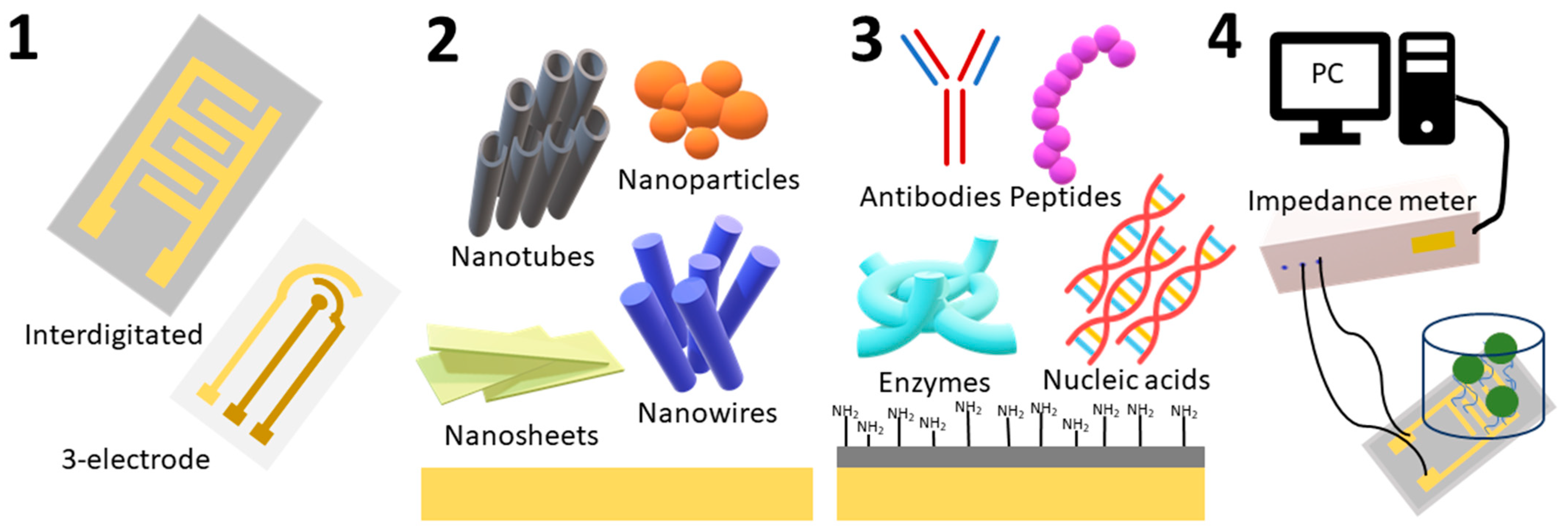

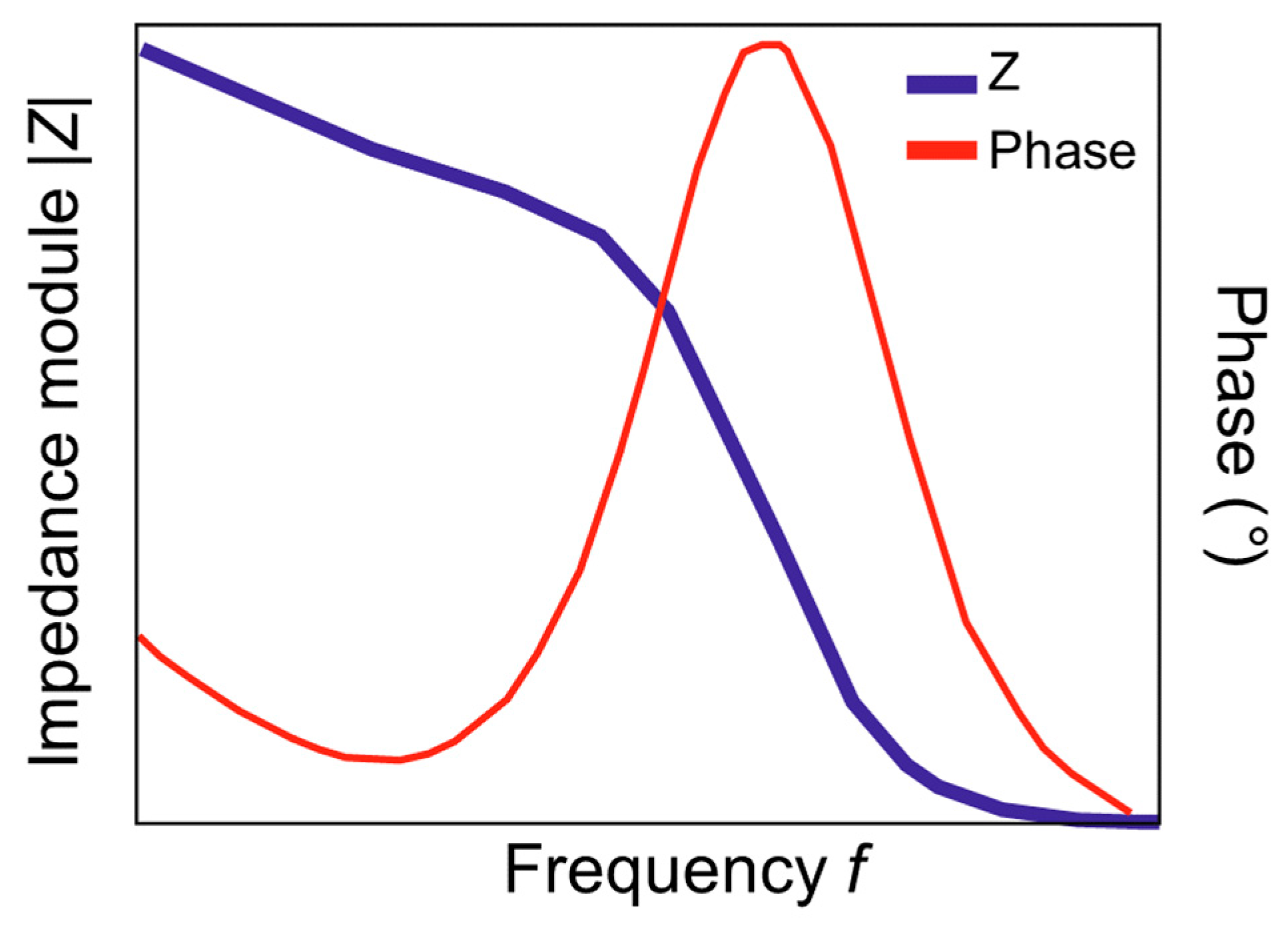


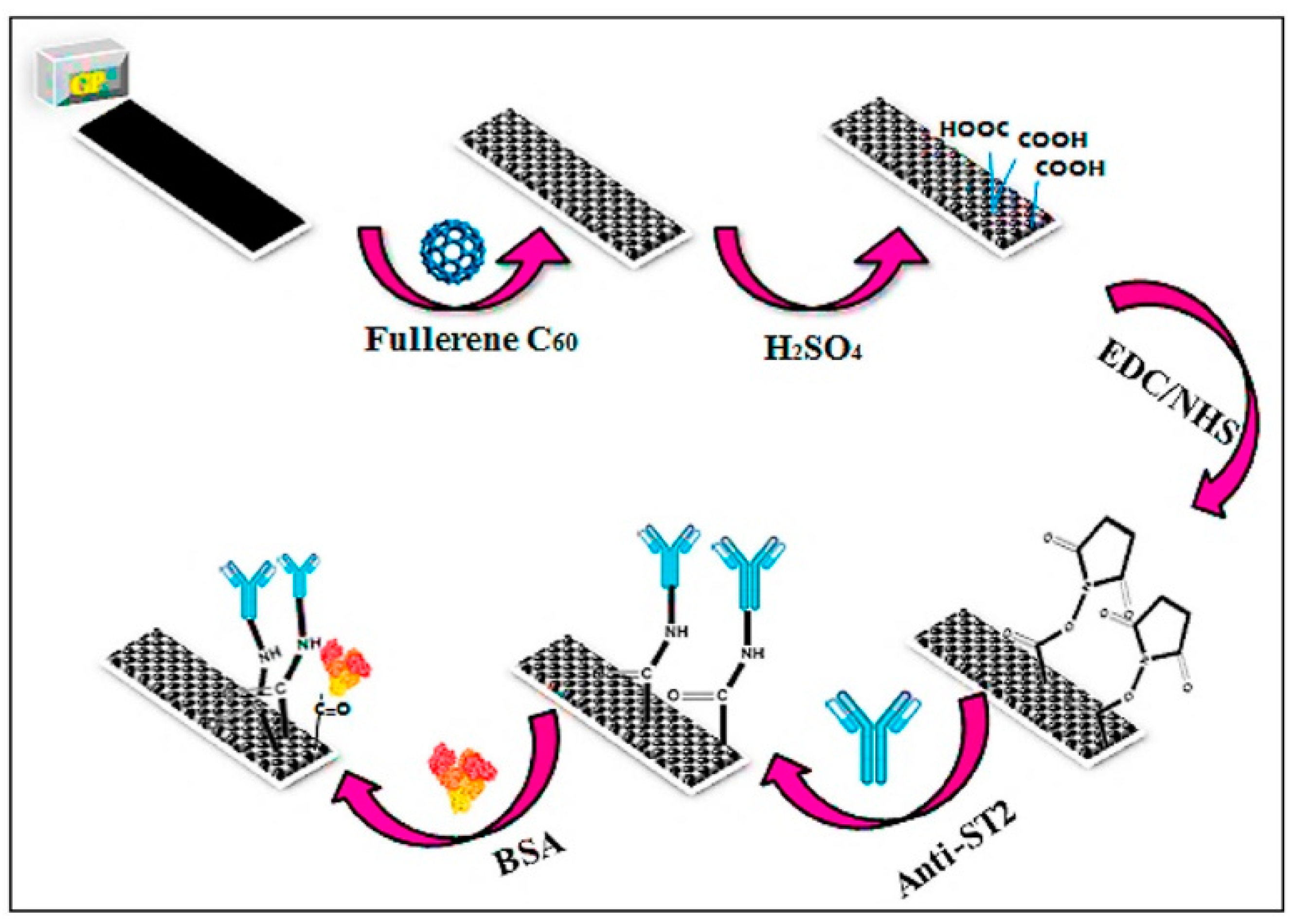

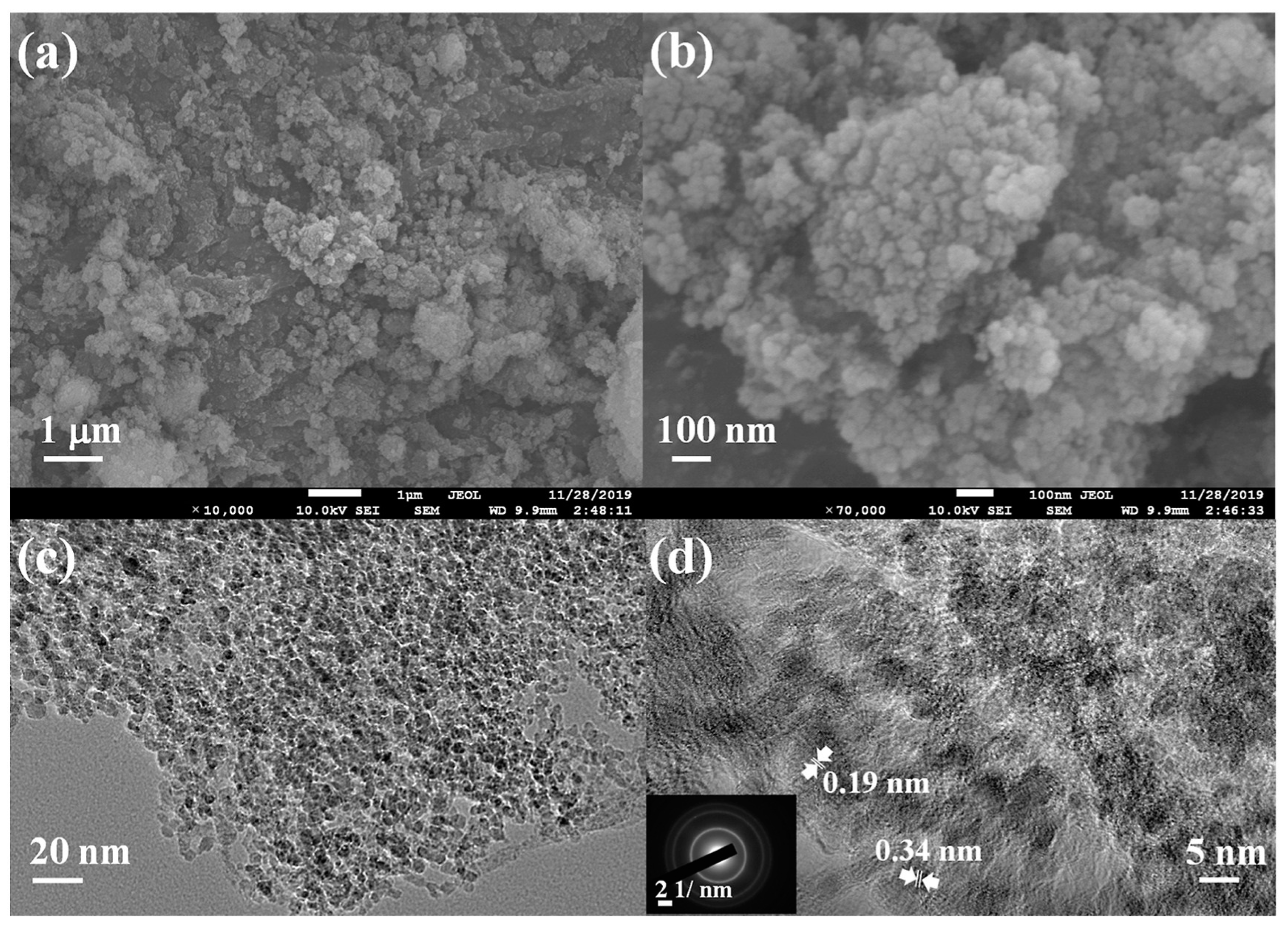
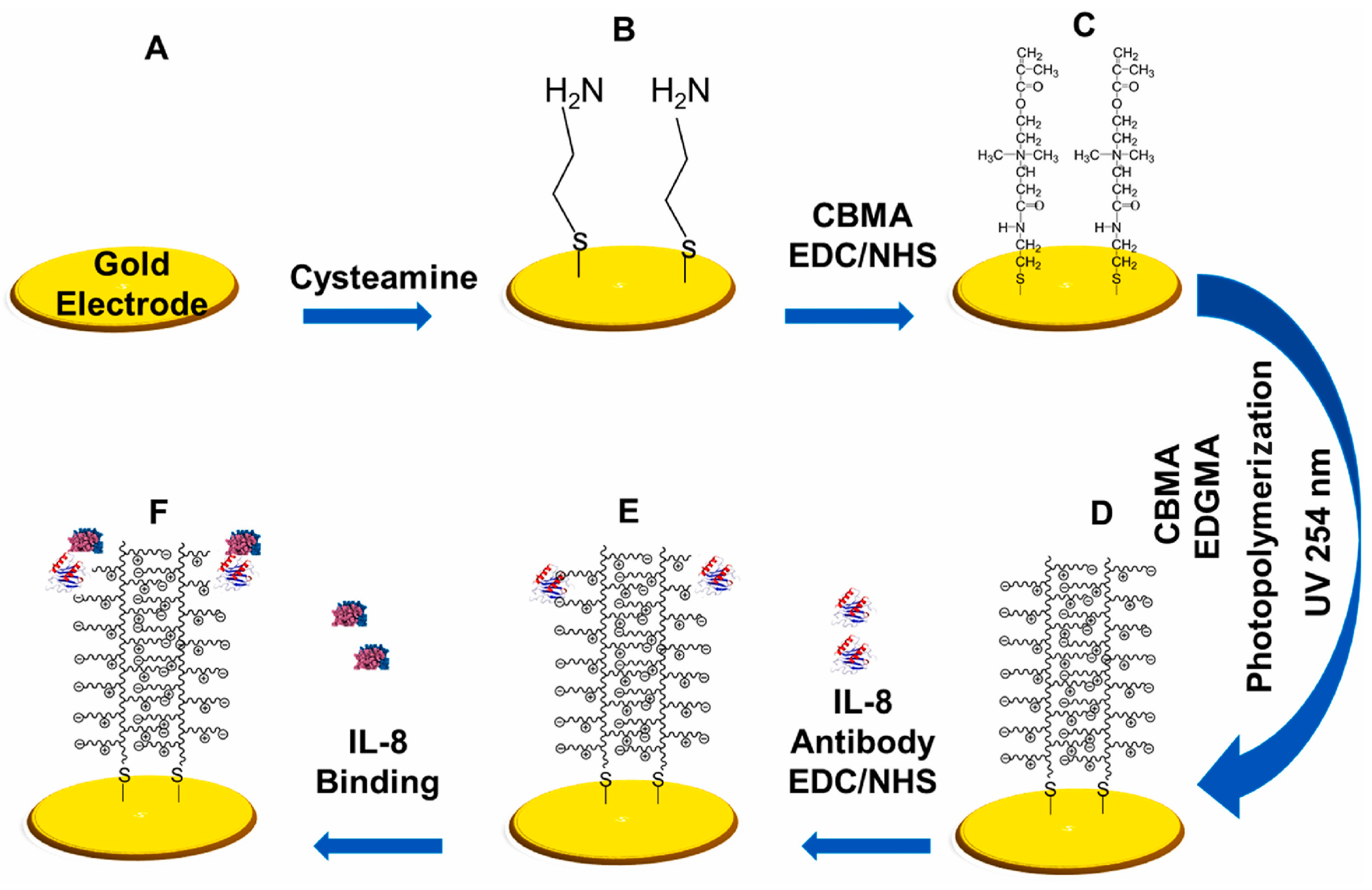
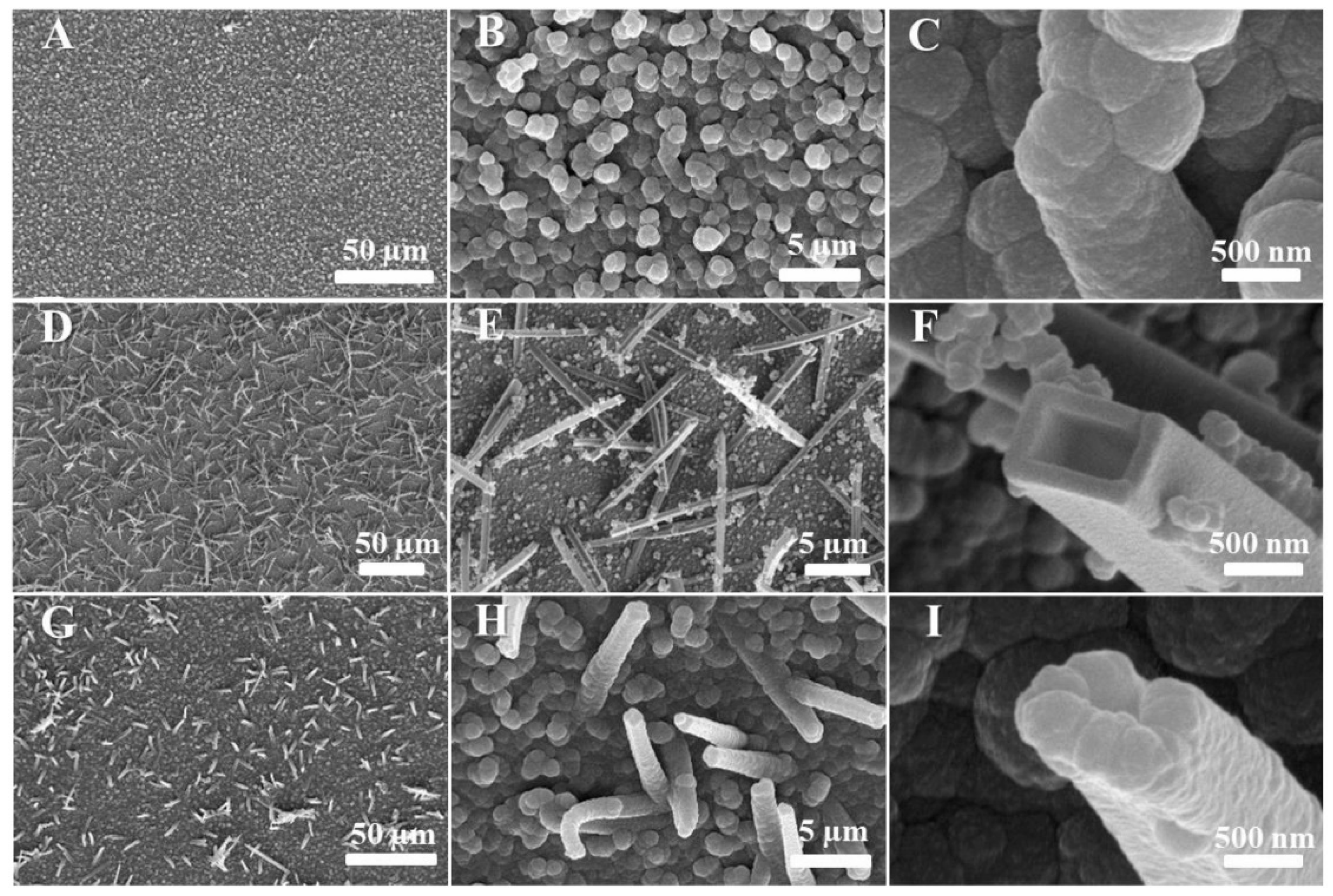


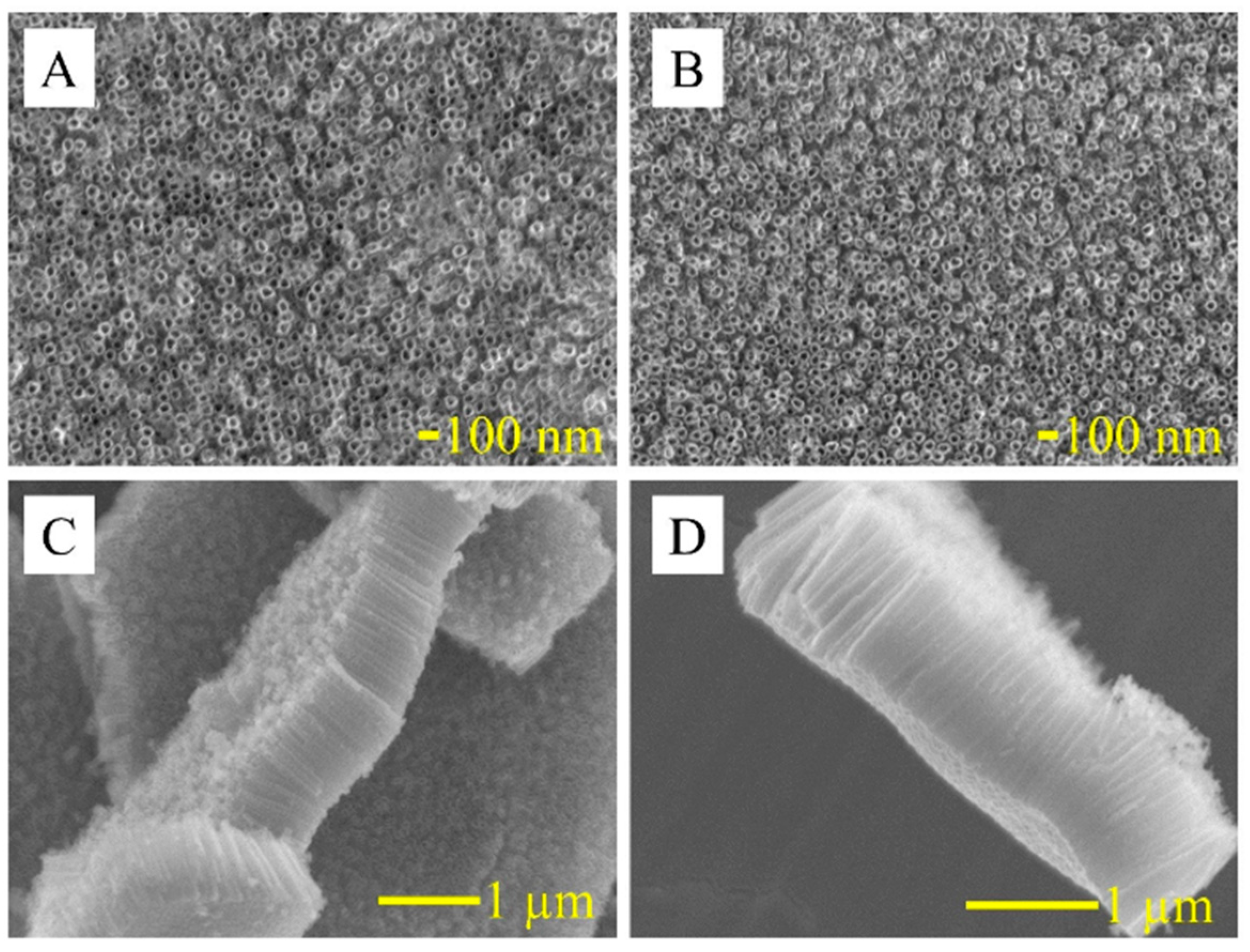
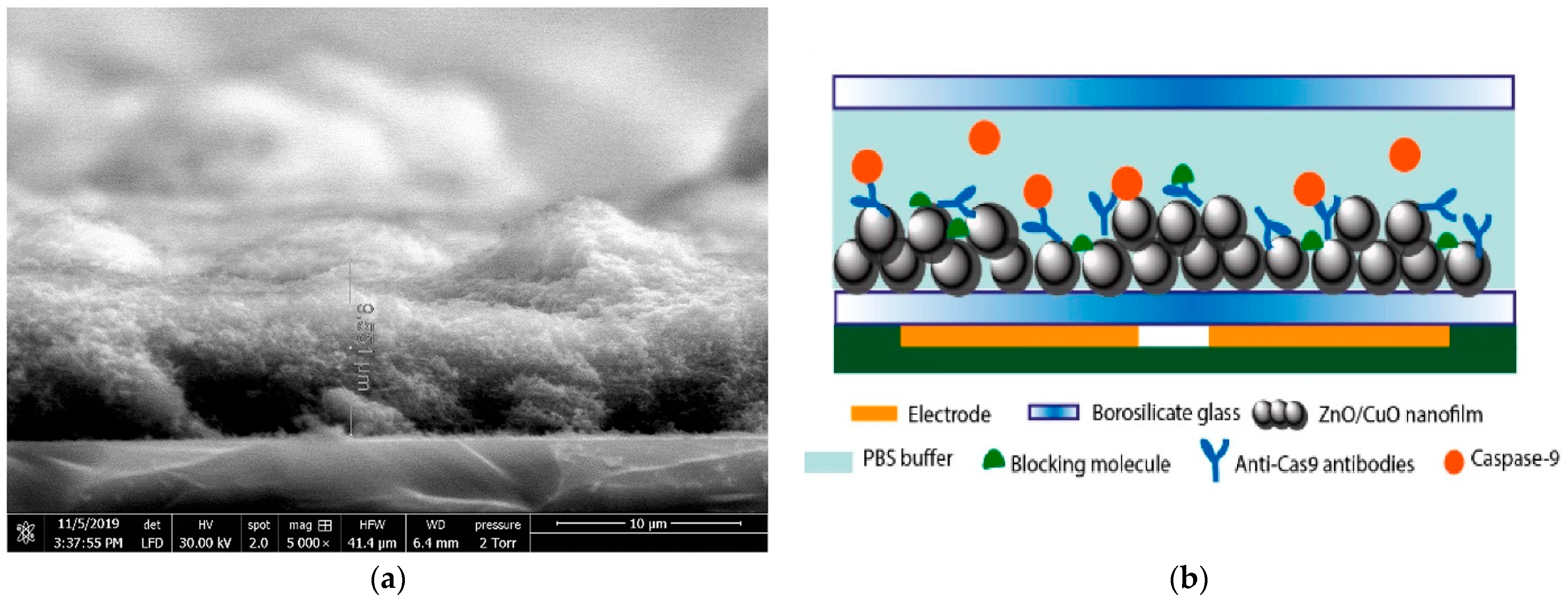
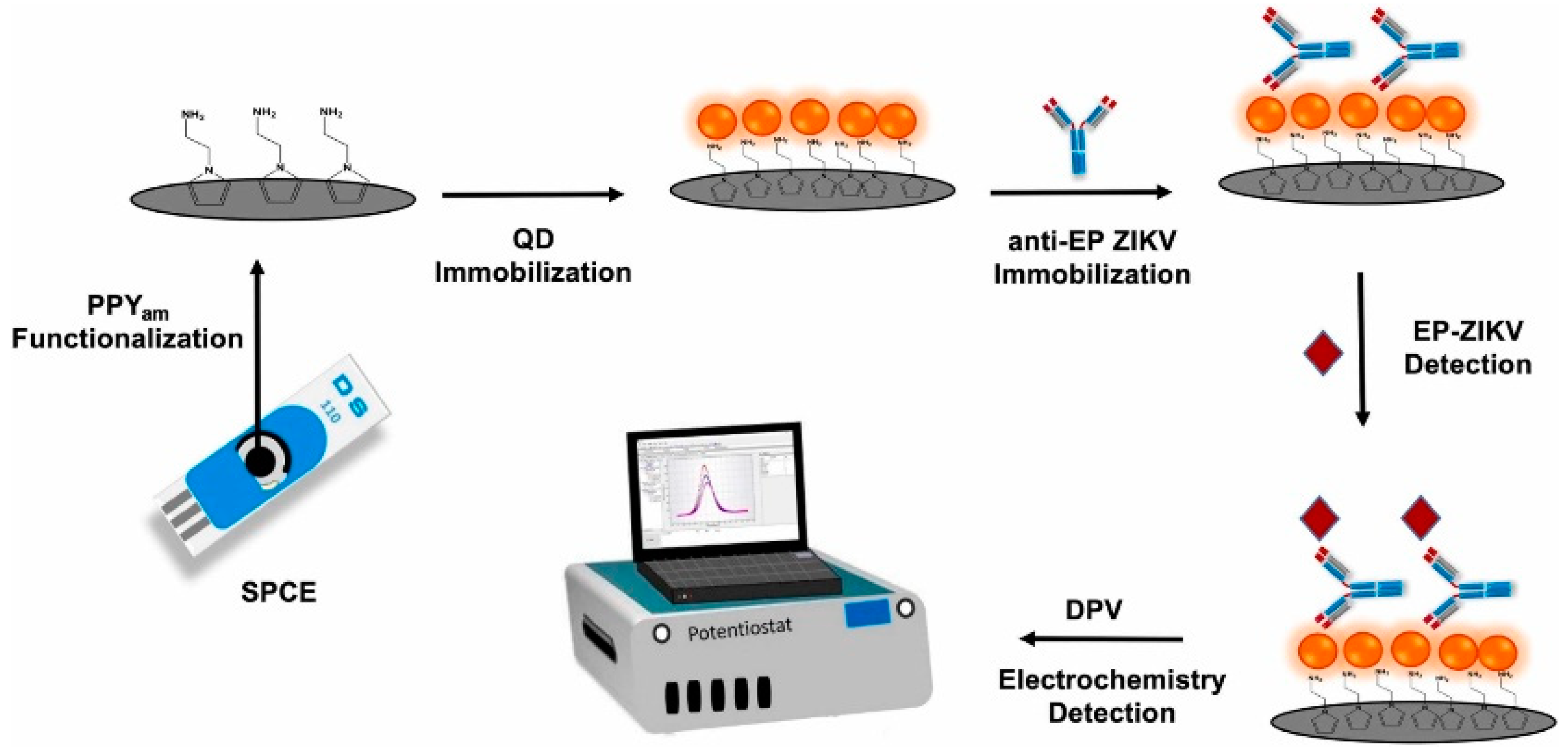
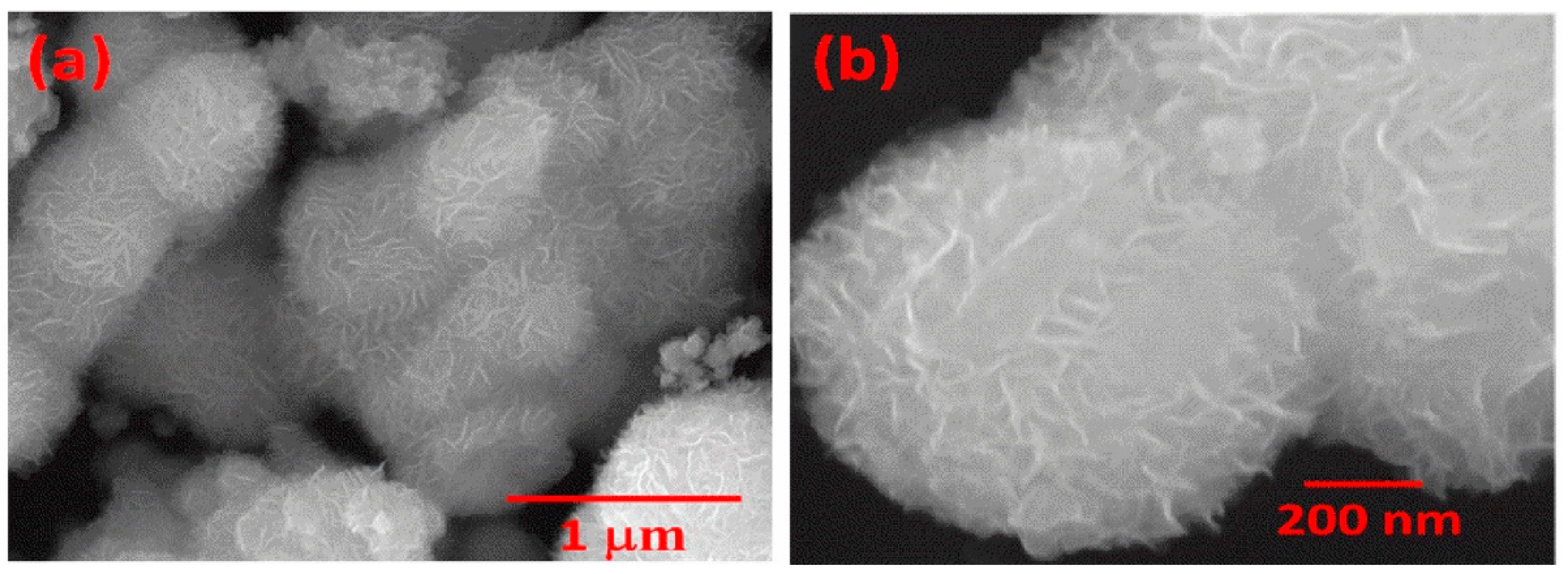
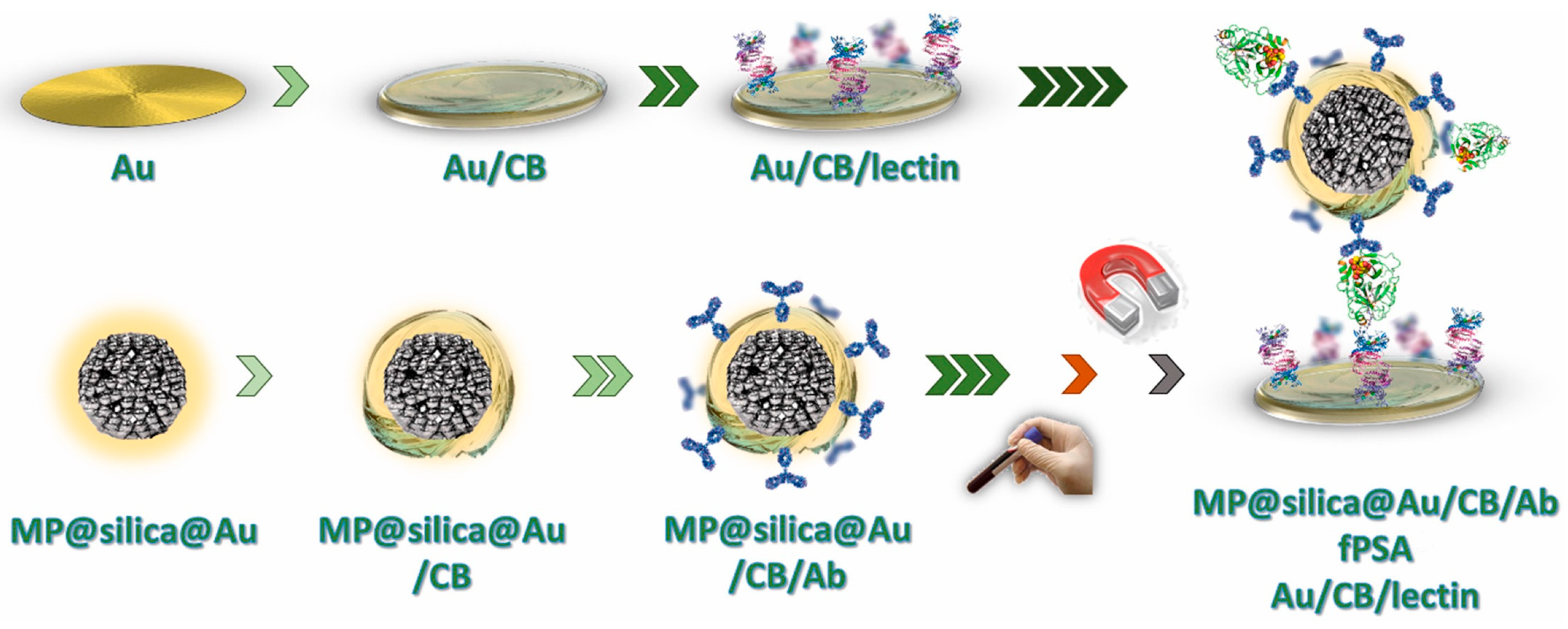
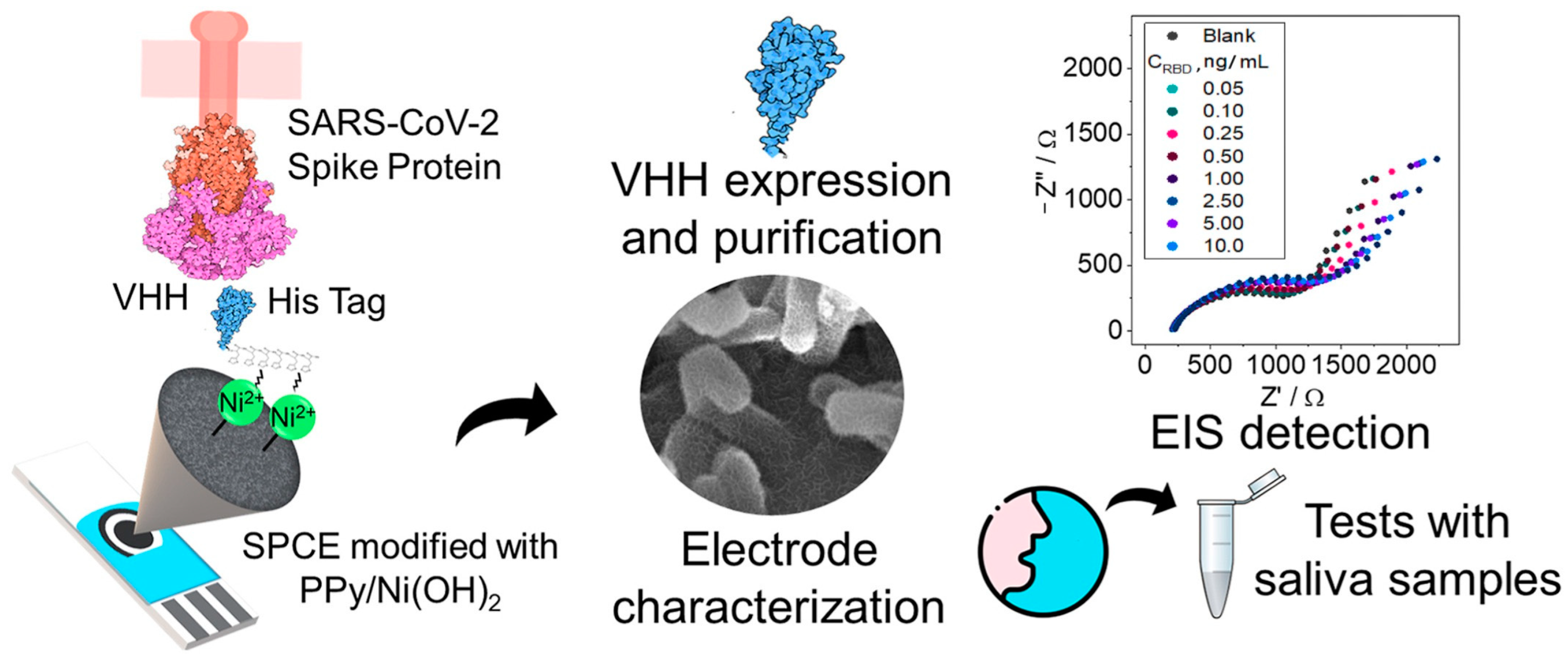
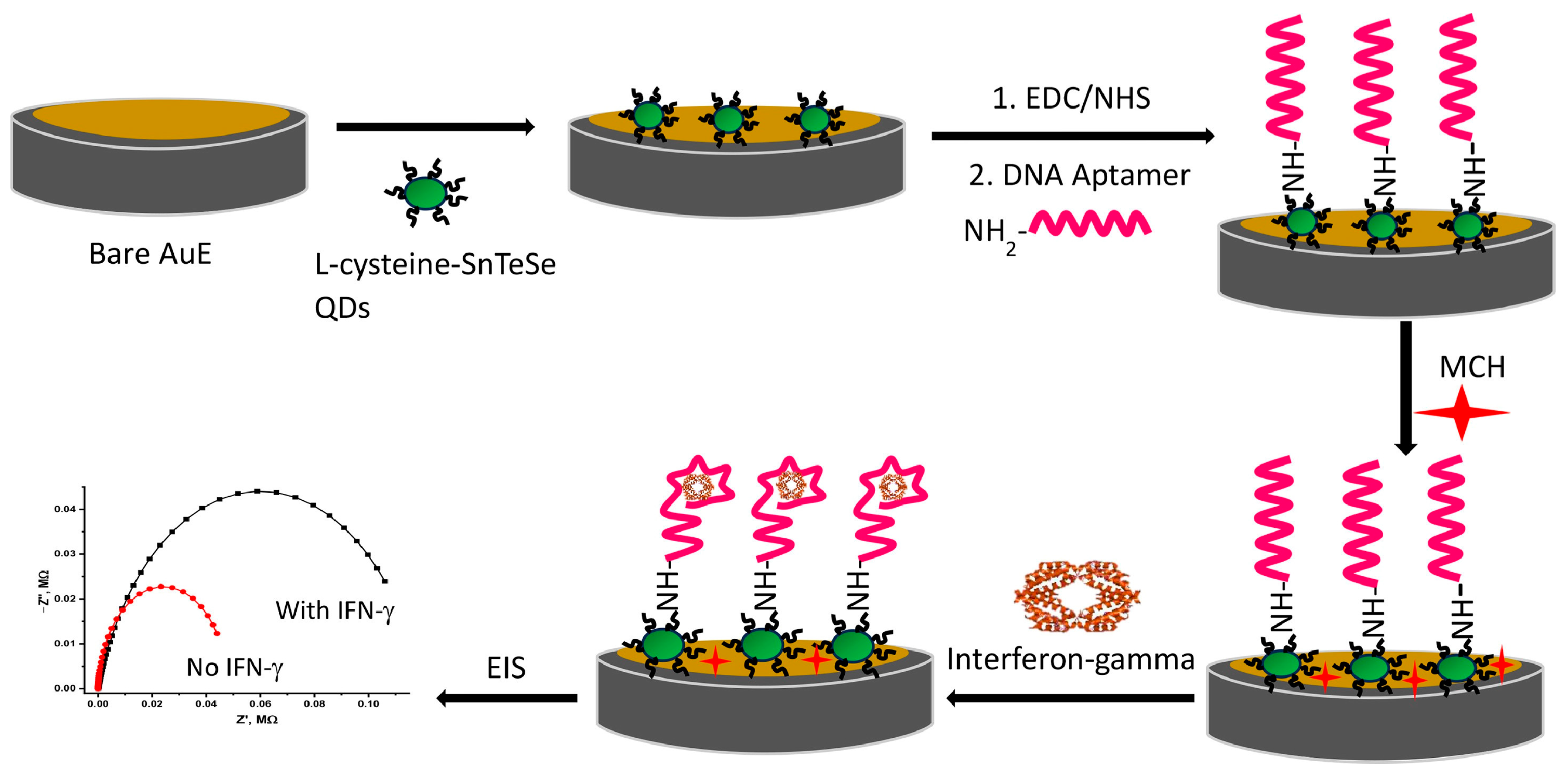
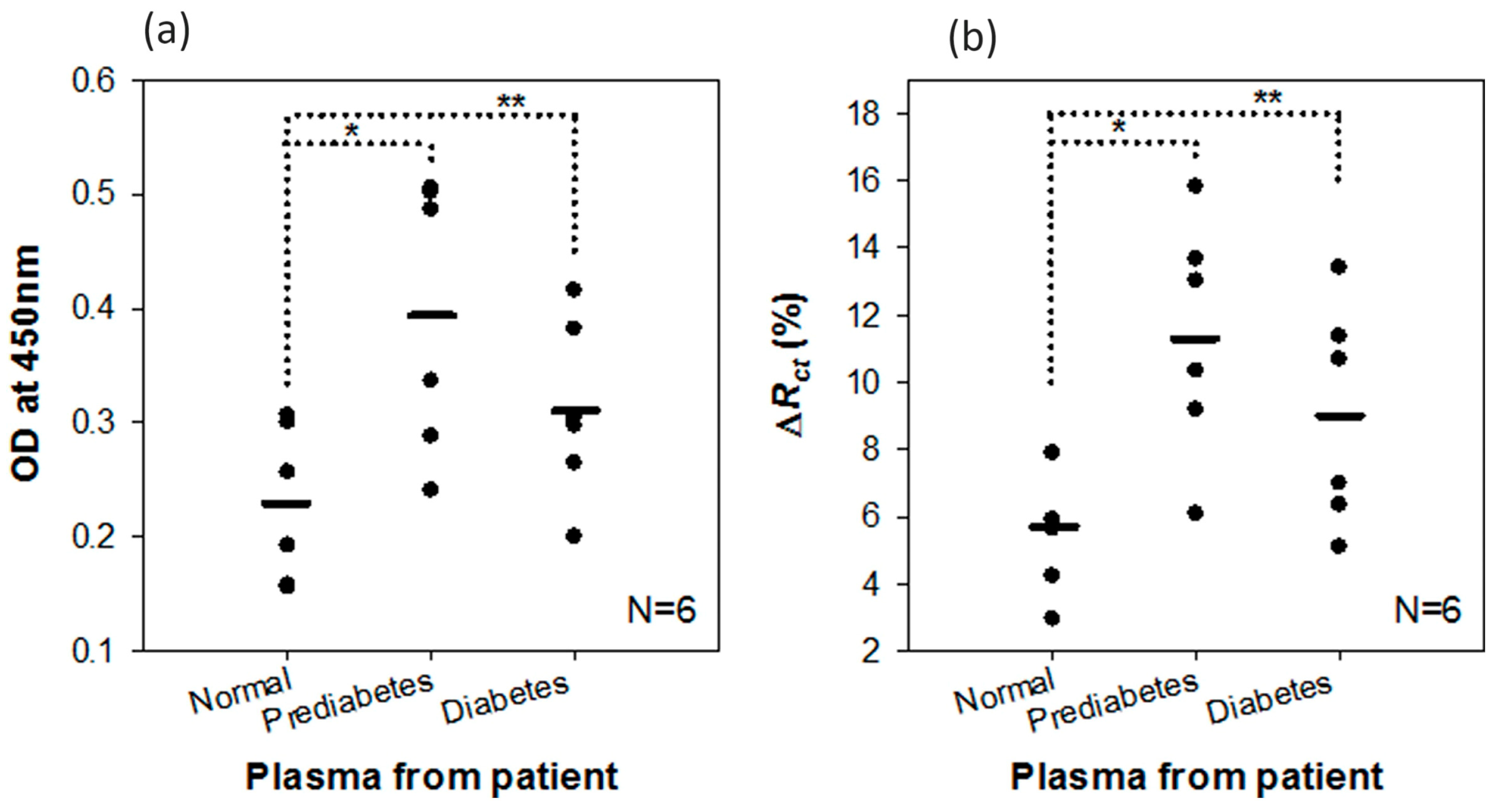
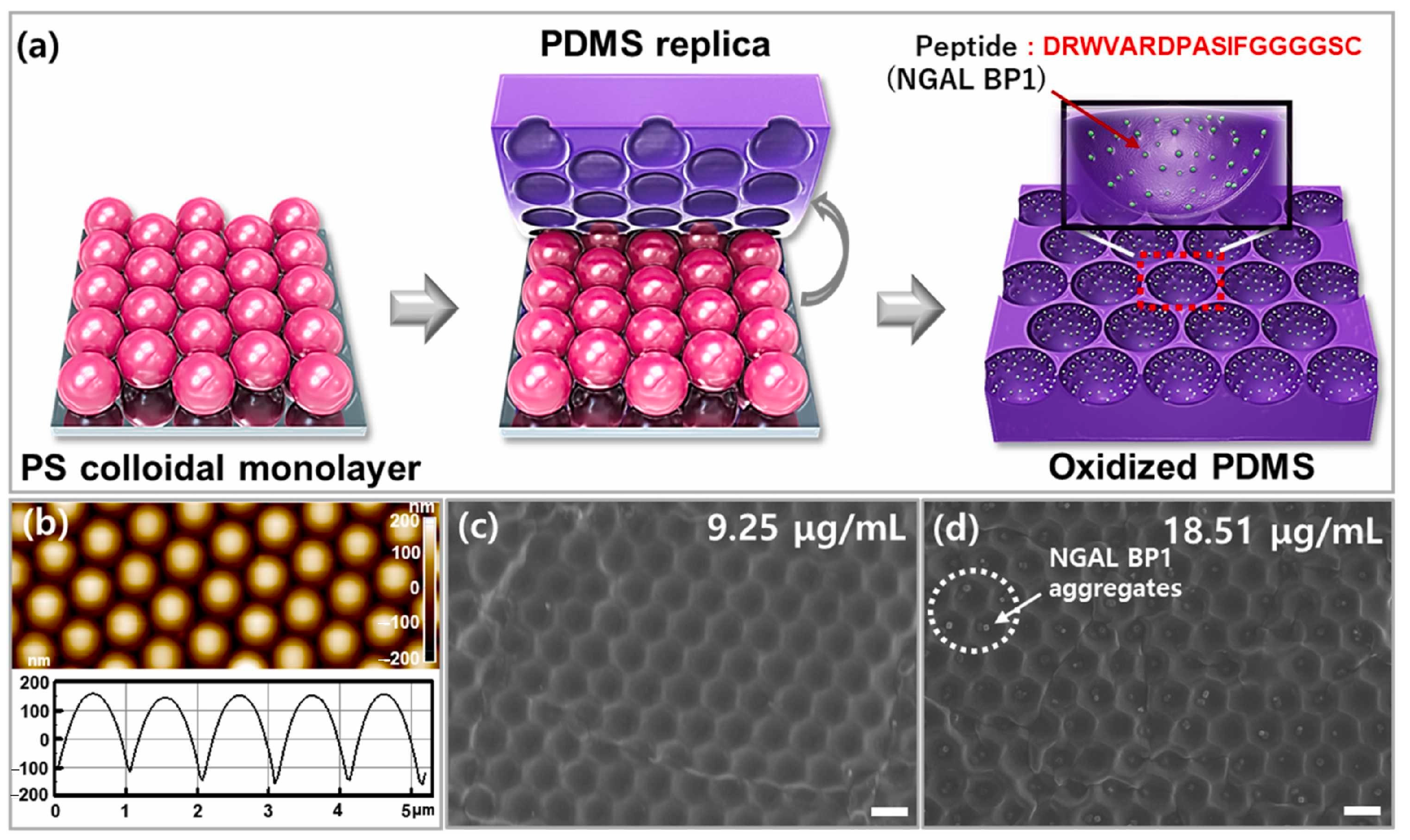
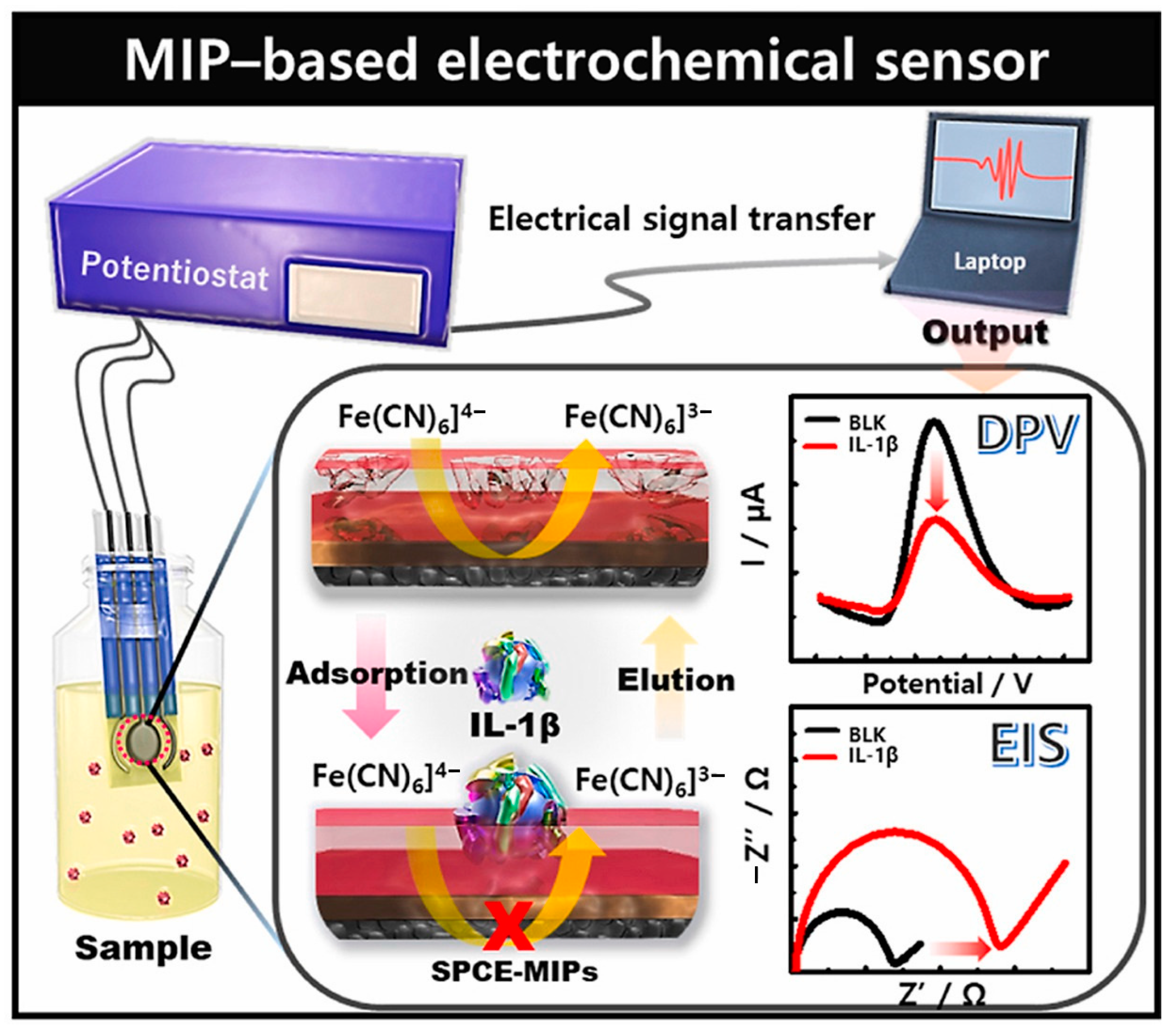
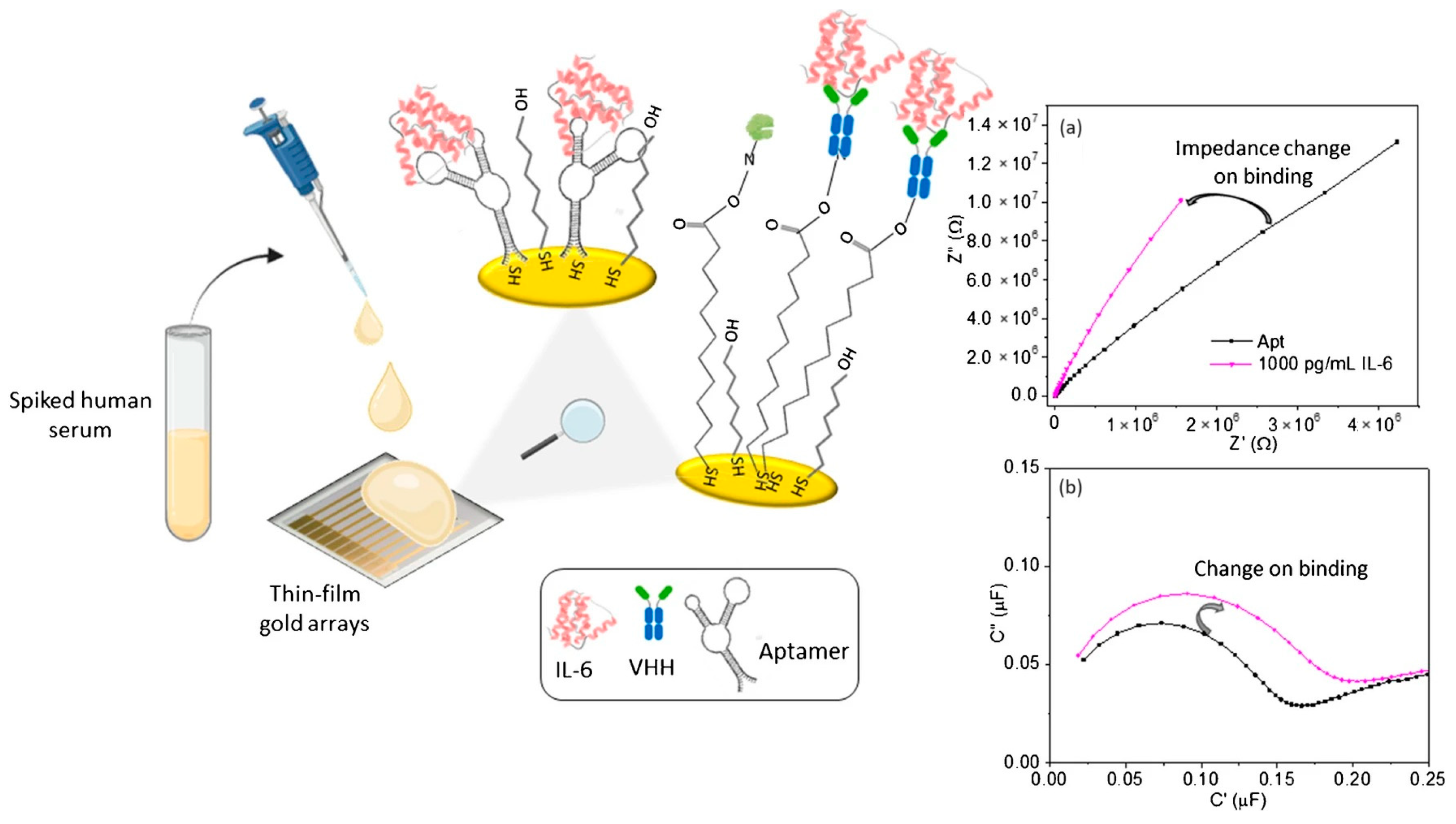
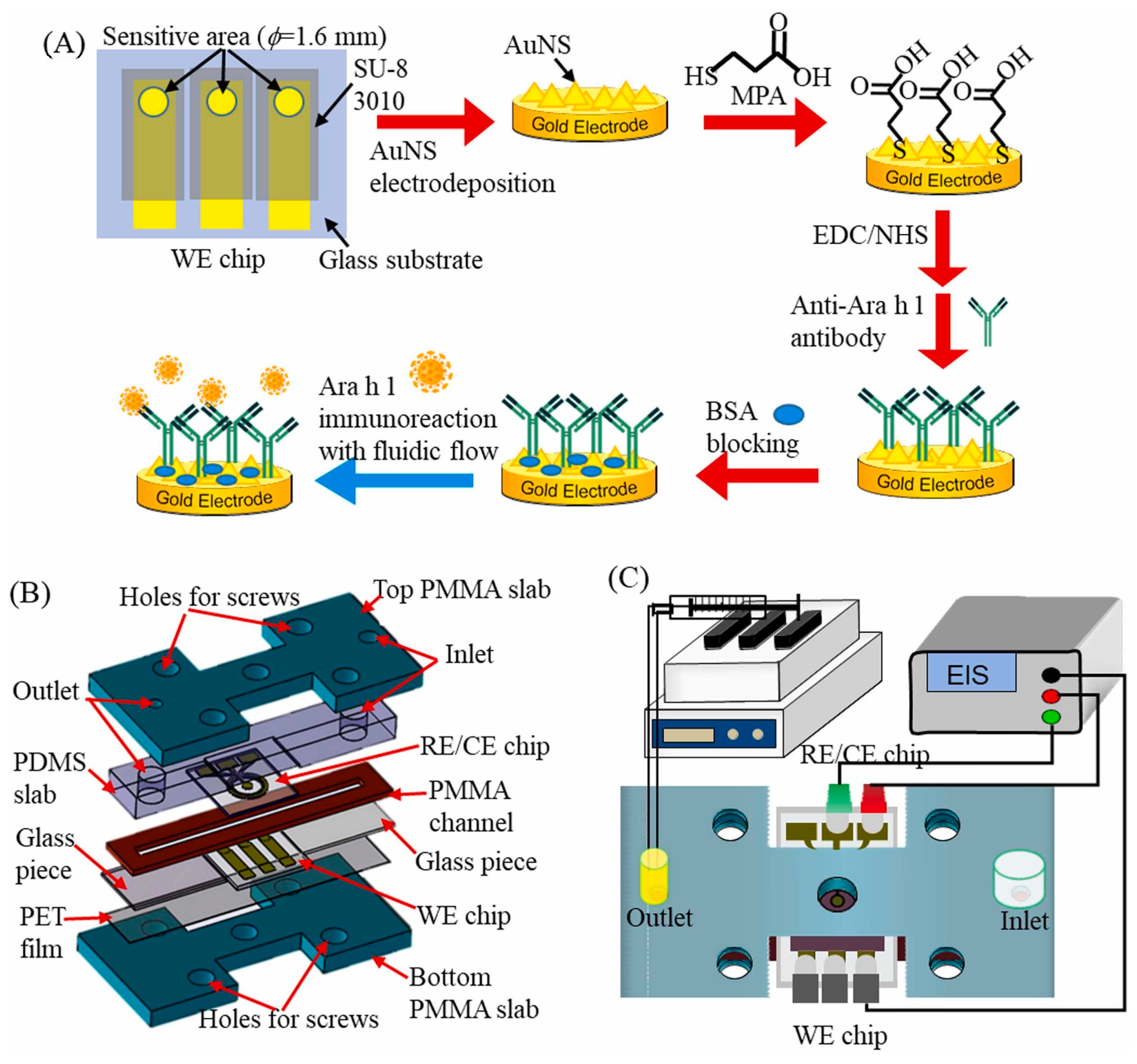
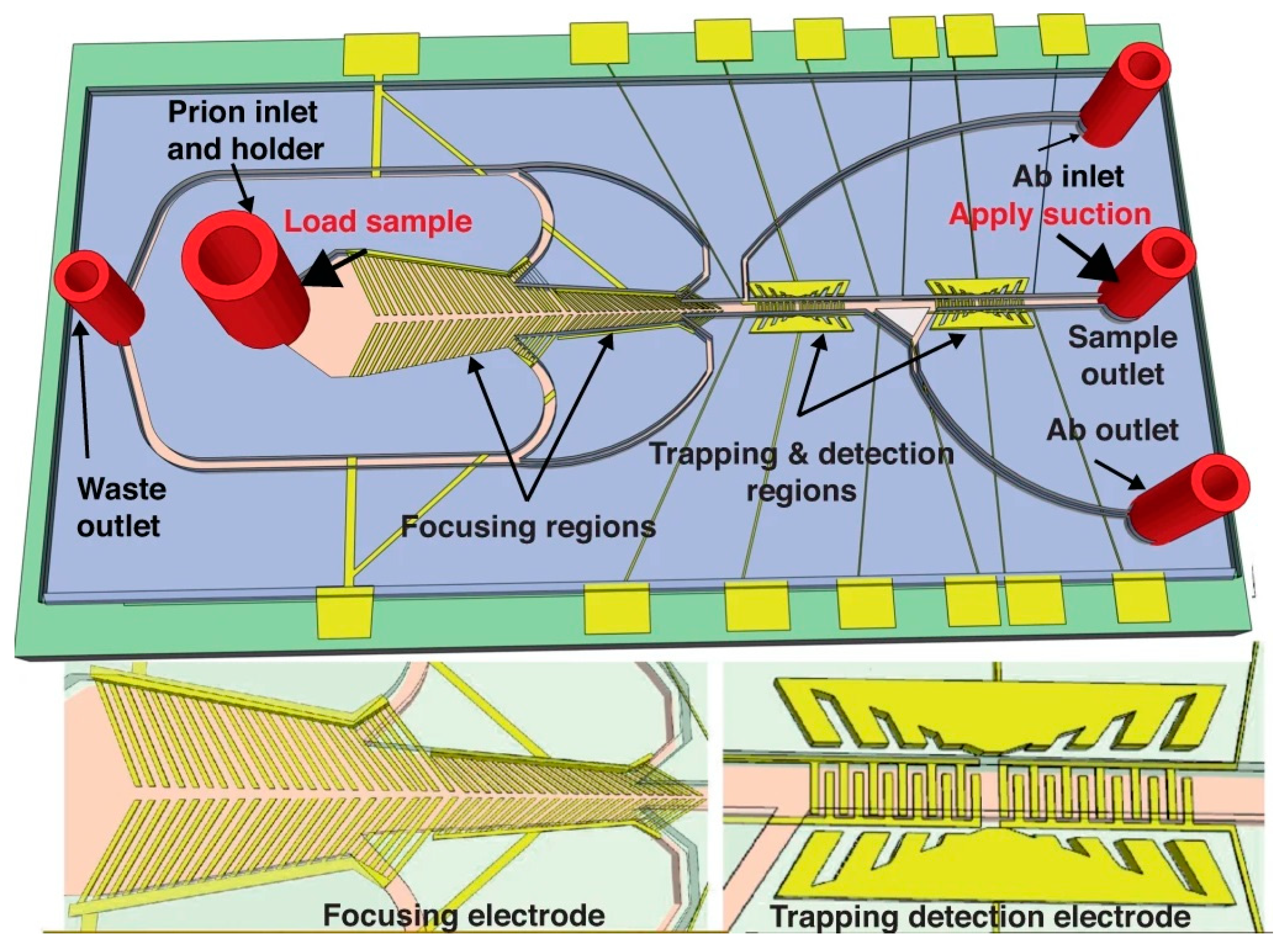
| Electrodes | Biorecognition Element | Target Protein | Matrix | Sensitivity | Refs. |
|---|---|---|---|---|---|
| Au-IDWμE | IgG-Fc fragment | IgM-RF | Human serum | 10–200 IU/mL range; LOD = 0.22 IU/mL | [57] |
| Au | anti-NS1 antibody | NS1 | Neat serum | 0.01–2.00 µg/mL range; LOD = 3 ng/mL | [58] |
| Au | anti-N antibody | N protein of SARS-CoV-2 | Human saliva | 4.4 ng/mL–4.4 pg/mL range; LOD = 0.362 ng/mL | [59] |
| Au | anti-human CRP antibody | C-reactive protein | Human serum | 0.5–50 nM range; LOD = 176 pM | [60] |
| Au-IDEs; Au-Colloidal Au NPs | antigen tTG | αtTG-Abs | Serum | 30 pM–30 nM range | [61] |
| Au | IgG-antibody | IgG | PBS buffer | 0.9–50 mg/L range | [62] |
| Au | anti-tau antibody | Tau | Human serum | 10−14–10−7 M range; LOD = 0.03 pM | [63] |
| Au | aptamer | N-terminal pro b-type natriuretic peptide | Artificial human saliva | 5.0 × 10−3–1.0 pg/mL range; LOD = 5.0 × 10−3 pg/mL | [64] |
| Au | anti-A1BG antibody | A1BG | Human serum | 1–300 ng/mL range; LOF = 1 ng/mL | [65] |
| Au | DNA aptamers | NS1 | Human serum | 0.025 ng/mL | [66] |
| Au | anti-A1AT antibody | A1AT | Artificial serum | 100–600 μg/mL range; LOD = 11.9 μg/mL | [67] |
| Au | anti-SPB antibody | SPB | Amniotic fluid | 2–2000 ng/m L range; LOD = 0.1 ng/mL | [68] |
| Au/Au NPs | aptamers anti-PSA and PSAG-1 | PSA | Human serum | 0.26–62.5 ng/mL (PSAG-1), 0.64–62.5 ng/mL (anti-PSA) range | [69] |
| Carbon; Au NPs | aptamer Gli4-T | PWG-Gliadin | Buffer | 0.1–1 mg/L of gliadin range; LOD = 0.05 mg/L | [71] |
| Glassy carbon/Au NPs | aptamer | IL-6 | Human serum | 5 pg/mL–100 ng/mL range; LOD = 1.6 pg/mL | [72] |
| Electrodes | Biorecognition Element | Target Protein | Matrix | Sensitivity | Refs. |
|---|---|---|---|---|---|
| ITO | anti-IL-8 antibody | IL-8 | Human serum and saliva | 0.02–3 pg/mL range; LOD = 6 fg/mL | [73] |
| FTO | anti-IL-1α antibody | IL-1α | Human serum and saliva | 0.02–2 pg/mL range; LOD = 6 fg/mL | [74] |
| ITO | anti-MAGE-1 antibody | MAGE-1 | Human serum | 4–200 fg/mL; LOD = 1.30 fg/mL | [75] |
| ITO | anti-PAK 2 antibody | PAK 2 | Human serum | 0.005–0.075 pg/mL range; LOD = 1.5 fg/mL | [76] |
| ITO | anti-PAK2 antibody | PAK-2 | Artificial and real human serum | 0.05–2.5 pg/mL range; LOD = 0.0252 pg/mL | [77] |
| ITO | anti-Aβ42 antibody | Aβ42 | Human serum | 1–100 pg/mL range; LOD = 0.37 pg/mL | [78] |
| VASiNWs/ITO | antibody (cTnIAb) | cTnI | Human blood sera | 1.76011–17,601.1 ng/mL range; LOD = 0.53 ng/mL | [79] |
| Electrodes | Biorecognition Element | Target Protein | Matrix | Sensitivity | Refs. |
|---|---|---|---|---|---|
| Carbon (SPCE) | bicyclic peptides | h-uPA | Buffer | 0.01–1 ng/mL range; LOD = 9 ng/mL | [80] |
| Carbon nanofibers | aptamer-LYS | Lysozyme (Lys) | Fetal bovine serum | LOD = 0.36 μg/mL | [81] |
| MWCNTs | anti-Mb-IgG antibody | Mb | Human serum | 0.1–90 ng/mL range; LOD = 0.08 ng/mL | [82] |
| MWCNTs | thrombin aptamer | α-thrombin | 5 mM [Fe(CN)6]3−/4− in PBS | 0.39–1.95 nM range; LOD = 105 pM | [83] |
| Carbon nanotube | anti-lysozyme DNA aptamer | LYS | 2.5 mM [Fe(CN)6]3−/4− in KCl | 12–400 µg/mL range; LOD = 12.09 µg/mL | [84] |
| MWCNT | anti-IL-8 antibody | IL-8 | PBS | 1–1000 pg/mL range; LOD = 0.1 pg/mL | [85] |
| MWCNT/AuNPs | anti-DJ-1antibody | DJ-1 | Cerebrospinal fluid and saliva | 4.7–4700 fg/mL range; LOD = 0.5 fg/mL | [86] |
| AuNPs@MWCNTs-GQDs | anti-PSA antibody | PSA | [Fe(CN)6]3−/4− in KCl | 1–10,000 pg/mL range; LOD = 0.48 pg/mL | [87] |
| Glassy carbon; boron-doped diamond | anti-N antibody | N protein of SARS-CoV-2 | Human saliva | 4.4 ng/mL–4.4 pg/mL range; LOD = 0.227 ng/mL (glassy carbon) and 0.334 ng/mL (boron-doped diamond) | [59] |
| C60-modified graphite paper | anti-ST2 antibody | ST2 | Human serum | 0.1–100 fg/mL range; LOD = 0.124 fg/mL | [88] |
| GP | anti-adiponectin antibody | Adiponectin | Human serum | 0.05–25 pg/mL range; LOD = 0.0033 pg/mL | [89] |
| GP/Au NPs | anti-CK antibody | Creatine kinase (CK) | Human blood | 0.1–50 pg/mL range; LOD = 0.045 pg/mL | [90] |
| Boron-doped diamond | anti-S1 antibody | Subunit S1 of SARS-CoV-2 | Complex matrix | 1 fg/mL | [91] |
| Gii-sense® Graphene Foam | anti-IL-10 antibody | IL-10 | Artificial saliva | 10–100 fg/mL range; LOD = 7.89 fg/mL | [92] |
| ErGO | lectin concanavalin A | Glycoprotein invertase (INV) | PBS | 10−14–10−8 mol range | [93] |
| rGO/AuNPs | anti-Tau antibody | Tau-441 | Serum and cerebrospinal fluid (CSF) | 1–500 pg/mL range; LOD = 0.091 pg/mL | [94] |
| Porous graphene oxide (PrGO) | anti-cTnI antibody | cTnI | Human blood | 0.1–10 ng/mL range; LOD = 0.07 ng/mL | [95] |
| rGO | anti-CEA antibody | CEA | Human blood serum | 0.1–5 ng/mL range; LOD = 0.05 ng/mL | [96] |
| AuNP electrode/GO | anti -HSP-47 antibody | HSP-47 | Cell lysates | 10–160 pg/mL range; LOD = 9.47 pg/mL | [97] |
| rGO-NP | anti-CRP antibody | CRP | PBS, Human serum | 1–1000 ng/mL range; LOD = 0.06 ng/mL (in PBS) and 0.08 ng/mL (in human serum) | [98] |
| Maze-like boron-doped carbon nanowall | anti-protein D antibodies | Protein D | PBS | 3.37 × 10−11–3.37 × 10−3 µg/mL range; LOD = 2.39 × 102 fg/mL | [99] |
| HsGDY@NDs | aptamers | cTnI; Myo | PBS | LOD = 6.29 fg/mL (cTnI); 9.04 fg/mL (Myo) | [100] |
| Electrodes | Biorecognition Element | Target Protein | Matrix | Sensitivity | Refs. |
|---|---|---|---|---|---|
| Poly ortho-phenylenediamine | mAβ antibody | Aβ40 | PBS | 1 pg/mL | [101] |
| Polycarboxybetaine methacrylate (pCBMA) | anti-IL-8 antibody | IL-8 | Nasal epithelial lining fluid | 55 fM–55 nM range; LOD = 10 fM | [102] |
| Polytyramine | anti-FGFR3-14 and FGFR3-21 affimer proteins | FGFR3 | PBS and synthetic urine | sub-pM–nM range | [103] |
| Copolymer of polytyr-amine/3-(4-hydroxyphenyl) propionic acid (POPA) | fragment of the cellular prion protein (PrPC, residues 95–110) | AβO | PBS | 10−12–10−6 M range; LOD~0.5 pM; (Aβ peptide) | [104] |
| Polyoctopamine | CEA affimer; anti-CEA antibody | CEA | Spiked human serum | 1–100 fM (affimer) and 1 fM–100 nM (antibody) range; LOD = 11.76 fM | [105] |
| Polypyrrole polymer | IL-6 receptor | IL-6 | Human serum | 0.02–16 pg/mL range; LOD = 6.0 fg/mL | [106] |
| Poly-pyrrole-pyrrole 3 carboxylic acid | antibodies (Ab-PfHRP2) | PfHRP2 | [Fe(CN)6]4−/3−+ KCl solution | 100–1000 ng/mL range; LOD = 27.47 ng/mL | [107] |
| Carboxy-endcapped conductive polypyrrole | anti-GPC3 antibody | gypican-3 (GPC3) | Human serum | 0.9 pg/mL to 9 ng/mL range; LOD = 0.3 pg/mL | [108] |
| Acid-substituted poly(pyrrole) | anti-CC chemokine receptor 4 (CCR4) antibodies | CCR4 | Human serum | 0.02–8 pg/mL range; LOD = 6.4 fg/mL | [109] |
| AuNPs/thiophene polymer P(ThiAmn) | anti-GM2A antibodies | GM2A | Human serum | 0.0185–111 pg/mL range; LOD = 5.8 fg/mL | [110] |
| acetylene black (AB)/epoxy-substituted-poly(pyrrole) polymer | anti-IL-6 antibodies | IL-6 | Spiked human serum | 0.01–50 pg/mL range; LOD = 3.2 fg/mL | [111] |
| Overoxidized polypyrrole decorated with gold nanoparticle | anti-HigG antibody | HigG | Human serum | 0.5–125.0 ng/mL range; LOD = 0.02 ng/mL | [112] |
| Methyl orange-doped polypyrrole | DMIP | CEA; AFP | Human serum | 5–104 pg/mL (CEA), 10–104 pg/mL (AFP) range; LOD = 1.6 pg/mL (CEA), 1.6 pg/mL (AFP) | [113] |
| Acetylene black/thiophene polymer | anti-RBD antibody | spike receptor (RBD) COVID-19 | Nasal secretions | 0.0012–120 pg/mL range; LOD = 0.58 fg/mL | [114] |
| Polyaniline (PANI) | IFN-γ antibody | IFN-γ | Human serum | 5–1000 pg/mL range; LOD = 3.4 pg/mL | [115] |
| (PEDOT)/Au NP composites | anti-VEGF antibody | VEGF | [Fe(CN)6]4−/3−+ KCl solution | 1–20 pg/mL range; LOD = 0.5 pg/mL | [116] |
| Silk protein with PEDOT:PSS | anti-VEGF165 antibodies | VEGF | Human serum | 1 pg/mL–1 μg/mL range; LOD = 1.03 pg/mL | [117] |
| Carbon black C45/polythiophene polymer | anti-CYFRA 21-1 antibody | CYFRA 21-1 | Human serum | 0.03–90 pg/mL range; LOD = 4.7 fg/mL | [118] |
| Acrylamide (and Fe3O4 NP decorated with MWCNT-GO composite) | MIP + anti-PSA antibody | PSA; Myo | Human serum and urine | 0.01–100 ng/mL (PSA), 1–20,000 ng/mL (Myo) range; LOD = 5.4 pg/mL (PSA), 0.83 ng/mL (Myo) | [119] |
| Polyglutamic acid (PGA) | anti-leptin antibody | leptin | [Fe(CN)6]4−/3−+ PBS solution | 0.2–20 pg/mL range; LOD = 0.00813 pg/mL | [120] |
| Biotinylated phenylalanine nanoparticle | Asp-Glu-Val-Asp (DEVD)-containing peptide | caspase-3 | [Fe(CN)6]4−/3− solution | 26 pM–125 pg/mL range | [121] |
| Gelatin | anti-SARS-CoV-2 Spike glycoprotein S1 antibody | SARS-CoV-2 spike glycoprotein S1 | PBS and nasopharyngeal fluid | 0.001–10 µg/mL range; LOD = 169 pg/mL (in PBS), 90 pg/mL (in nasopharyngeal fluid) | [122] |
| 3-Aminophenol polymer | MIP | Tau protein | PBS | 2.18 pM–2.18 nM range; LOD = 0.02 pM | [123] |
| Binding peptide (BP1)-imprinted film | MIP | neutrophil gelatinase-associated lipocalin | PBS | LOD = 0.07 μg/mL | [124] |
| Polydopamine | MIP | IL-6 | [Fe(CN)6]4−/3−+ PBS solution | 1–200 pg/mL range; LOD = 0.25 pg/mL | [125] |
| NiO NP/ePDA | MIP | Trp | [Fe(CN)6]3−/4− solution | 1–90 pg/mL range; LOD = 0.75 pg/mL | [126] |
| Poly(chromotrope 2R) (C2R) | MIP | IL-1β | PBS solution | LOD = 0.23 pg/mL | [127] |
| Au NPs conjugated with Dihexadecylphosphate | mAb-DD antibody | D-dimer (DD) | PBS | LOD = 8.92 ng/mL | [128] |
| PAMAM generation 2 | DNA aptamer | APC | [Fe(CN)6]4−/3−+ KCl solution; fetal bovine serum | 0.74–7.5 range; µg/mL LOD = 0.74 µg/mL (in buffer), 2.03 µg/mL (in serum) | [129] |
| PAMAM generation 2 | DNA aptamer | APC | [Fe(CN)6]4−/3−+ KCl solution; fetal bovine serum | 1–2.5 µg/mL; LOD = 1.81 µg/mL (in buffer), 0.02 µg/mL (in diluted fetal bovine serum) | [130] |
| Fullerene–PAMAM(G5) composite | anti-Fetuin-A antibody | HFA | Real blood samples | 1.66–134 ng/mL range; LOD = 0.48 ng/mL | [131] |
| Electrodes | Biorecognition Element | Target Protein | Matrix | Sensitivity | Refs. |
|---|---|---|---|---|---|
| Cu-MOF | Ab2-CA15-3 antibody (and Ab1 on Au NPs) | CA15-3 | [Fe(CN)6]4−/3−+ KCl solution | 10 μU/mL–10 mU/mL and 10 mU/mL–100 U/mL ranges; LOD = 5.06 μU/mL for CA15-3 | [132] |
| Cu3(BTC)2 (copper-MOF)/PANI composite | anti-cTnI antibodies | cTnI | [Fe(CN)6]4−/3−+ PBS solution | 1–400 ng/mL range; LOD = 0.8 ng/mL | [133] |
| FeCo-MOF/nickel foam | IL-1RA antibodies | IL-1RA | PBS and human serum | 10 fg/mL–10 ng/mL range; LOD = 7.30 fg/mL (in buffer), 7.22 fg/mL (in serum) | [134] |
| Au@UiO-66-NH2 | DNA biomimetic clamp | 2 nucleocapsid protein (SARS-CoV-2 antigen) | Saliva and serum | LOD = 0.31 pg/mL | [135] |
| Zr(III) tetra(4-aminophenyl) porphyrin (TAPP) complex | antibody of NSE | NSE | [Fe(CN)6]4−/3−+ PBS solution | 10.0 fg/m–2.0 ng/mL range; LOD = 7.1 fg/mL | [136] |
| Co phthalocyanines–Ce oxide NP conjugate | HB5 aptamer | HER2 | Human serum | 1–10 ng/mL range; LOD = 0.2 ng/mL | [137] |
| Cobalt-based phthalocyanine/graphene quantum dots | HB5 aptamer | HER2 | Human serum | LOD = 0.0027 ng/mL | [138] |
| Electrodes | Biorecognition Element | Target Protein | Matrix | Sensitivity | Refs. |
|---|---|---|---|---|---|
| Au NPs/TiO2 NPs | DNA aptamer | leptin | Human serum | 1.0–100.0 pg/mL and 100.0–1000.0 pg/mL ranges; LOD = 0.312 pg/mL | [139] |
| Polymer/TiO2 NPs | protein A | IgG | [Fe(CN)6]4−/3−+ KCl solution | 0.0062–500 µg/mL range; LOD = 0.57 ng/mL | [140] |
| Titanium dioxide nanotube (TNT) array | anti-IL-6, anti-IL-8, and anti-TNFα AB | IL-6, IL-8, TNFα | PBS | 5–2500 pg/mL range; LOD = 5 pg/mL | [141] |
| AuNPs/WO3/CNTs | SARS-CoV-2 antibodies | SARS-CoV-2-S protein | [Fe(CN)6]4−/3− in buffer solution | 0.125–16.0 pg/mL ranges; LOD = 1.8 pg/mL | [144] |
| Tungsten trioxide nanosheets (WO3 NS) | anti-cTnI antibodies | cTnI | [Fe(CN)6]4−/3−+ PBS solution | 0.1–100 ng/mL range | [145] |
| ZnO/CuO composite nanoparticle | anti-cas9 antibody | caspase-9 | Buffer solution | 0.1–1 U/mL range; LOD = 0.07 U/mL | [51] |
| Silicon nitride | anti-HSA antibodies | HSA | PBS | 10−13–10−7 M range; LOD = 10−14 M | [146] |
| Glass | anti-HSA antibodies | HSA | PBS | LOD = 2 × 10−4 mg/mL | [147] |
| SiO2 | anti-pLDH Antibody | pLDH | Saliva | LOD = 250 pg/mL | [148] |
| ZnO thin film | antibodies | PCT, CRP | Human serum and blood | 0.01–10 ng/mL (PCT), 0.01–20 µg/mL (CRP), ranges; LOD = 0.10 ng/mL (PCT); 0.10 µg/mL (CRP) | [149] |
| ZnO–CuO composite | anti-CRP antibodies. | CRP | PBS | 1–10 ng/mL range | [150] |
| Nano-ZnO/CuO membranes | anti-CRP antibodies | CRP | PBS | 0.1–15 ng/mL range; LOD = 16 pg/mL | [151] |
| Electrodes | Biorecognition Element | Target Protein | Matrix | Sensitivity | Refs. |
|---|---|---|---|---|---|
| L-cysteine-SnTeSe QD | interferon-gamma aptamer | interferon-gamma | Serum samples | 10–55 pg/mL range; LOD = 0.151 pg/mL | [152] |
| Carboxylated CdTe QDs | anti-EP DIII ZIKV antibodies | EP-ZIKV | [Fe(CN)6]3−/4− + buffer | LOD = 0.1 ng/mL | [153] |
| MoS2 nf | anti-TNF-α antibodies | TNF-α | Serum samples | 1–200 pg/mL range; LOD = 0.202 pg/mL | [154] |
| AuNPs/Ti3C2-MXenes | aptamers | cTnI, Myo | [Fe(CN)6]3−/4− + buffer | 0.24 fg/mL–24 ng/mL (cTnI), 1–72 ng/mL (Myo) ranges; LOD = 0.14 fg/mL (cTnI), 0.2 ng/mL (Myo) | [155] |
| Au-NPs decorated MoS2 nanosheet | C-RP antibody | C-RP | Human serum | 1 fg/mL–1 μg/mL range; LOD = 0.01 fg/mL | [156] |
| MP@silica@Au/CB | anti-fPSA antibody (and lectin (SNA-I) for Au-electrode/CB) | PSA | Spiked human serum | 0.01–1 pg/mL range; LOD = 1.2 fM | [157] |
| Magnetic nanoparticles | anti-CRP polyclonal antibody (and anti-CRP monoclonal antibody on electrode) | CRP | PBS | 10–200 ng/mL range; LOD = 0.34 ng/mL | [158] |
Disclaimer/Publisher’s Note: The statements, opinions and data contained in all publications are solely those of the individual author(s) and contributor(s) and not of MDPI and/or the editor(s). MDPI and/or the editor(s) disclaim responsibility for any injury to people or property resulting from any ideas, methods, instructions or products referred to in the content. |
© 2024 by the authors. Licensee MDPI, Basel, Switzerland. This article is an open access article distributed under the terms and conditions of the Creative Commons Attribution (CC BY) license (https://creativecommons.org/licenses/by/4.0/).
Share and Cite
Sitkov, N.; Ryabko, A.; Moshnikov, V.; Aleshin, A.; Kaplun, D.; Zimina, T. Hybrid Impedimetric Biosensors for Express Protein Markers Detection. Micromachines 2024, 15, 181. https://doi.org/10.3390/mi15020181
Sitkov N, Ryabko A, Moshnikov V, Aleshin A, Kaplun D, Zimina T. Hybrid Impedimetric Biosensors for Express Protein Markers Detection. Micromachines. 2024; 15(2):181. https://doi.org/10.3390/mi15020181
Chicago/Turabian StyleSitkov, Nikita, Andrey Ryabko, Vyacheslav Moshnikov, Andrey Aleshin, Dmitry Kaplun, and Tatiana Zimina. 2024. "Hybrid Impedimetric Biosensors for Express Protein Markers Detection" Micromachines 15, no. 2: 181. https://doi.org/10.3390/mi15020181
APA StyleSitkov, N., Ryabko, A., Moshnikov, V., Aleshin, A., Kaplun, D., & Zimina, T. (2024). Hybrid Impedimetric Biosensors for Express Protein Markers Detection. Micromachines, 15(2), 181. https://doi.org/10.3390/mi15020181







